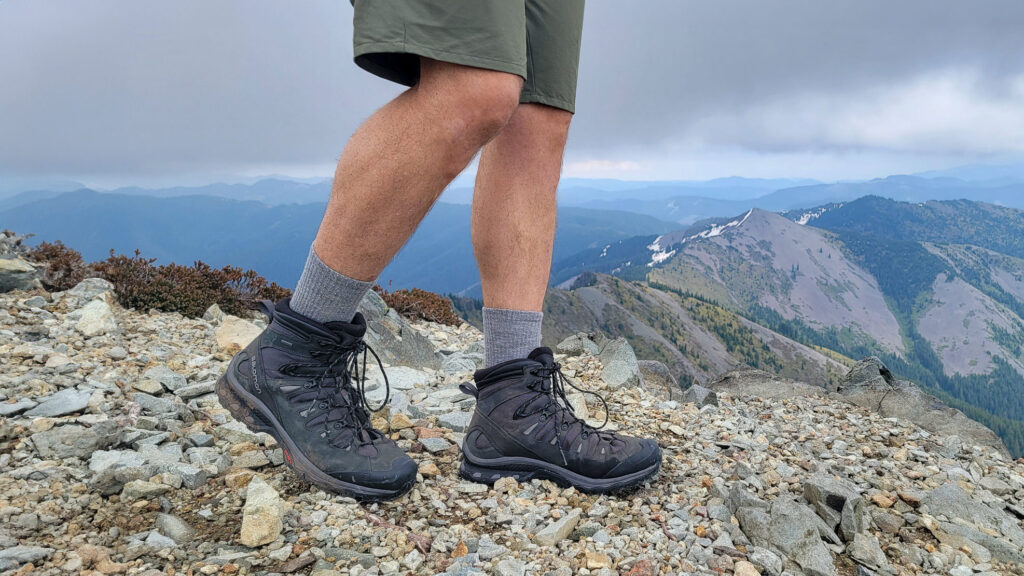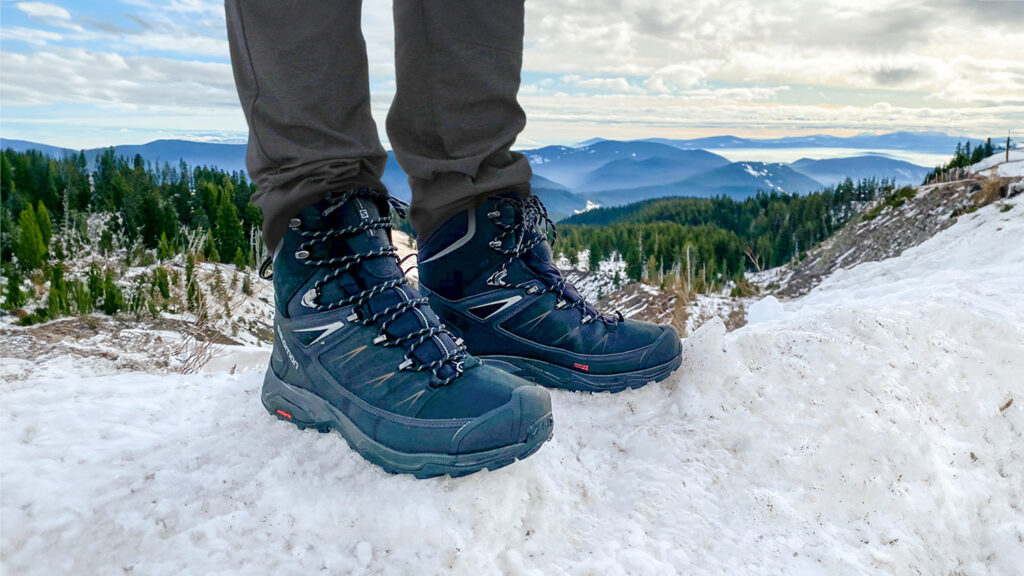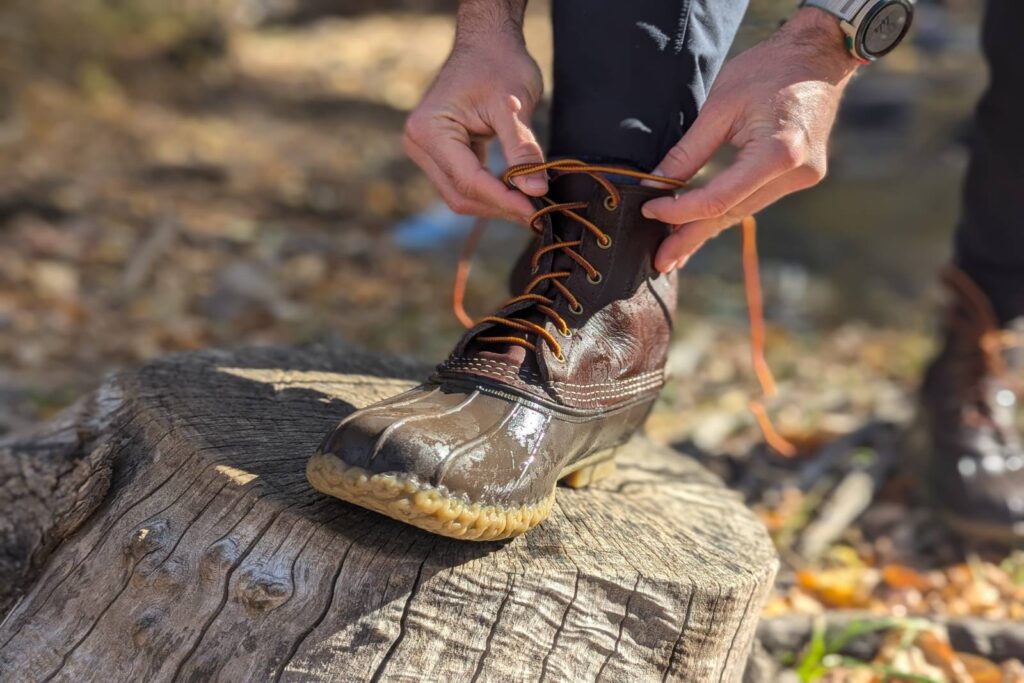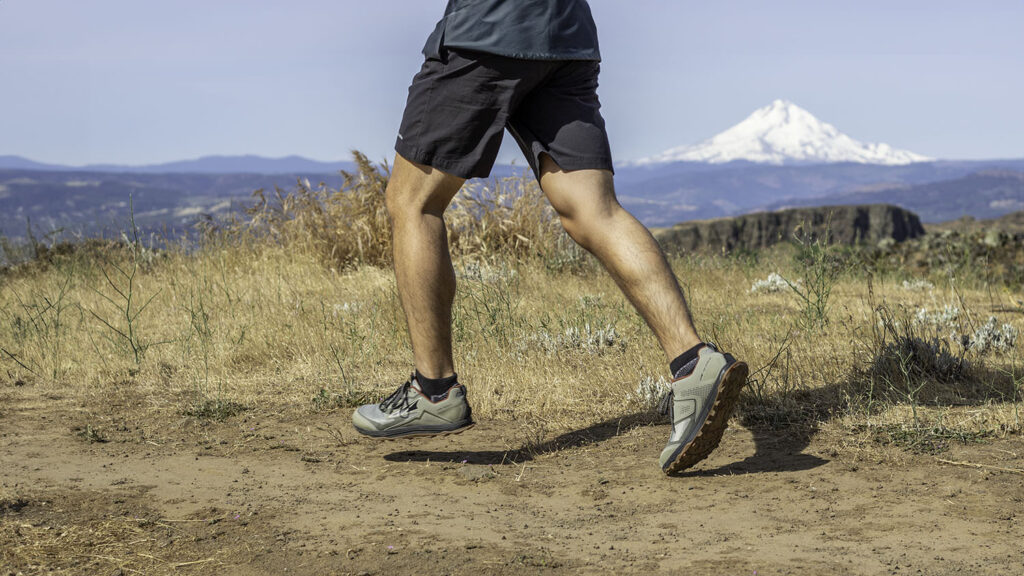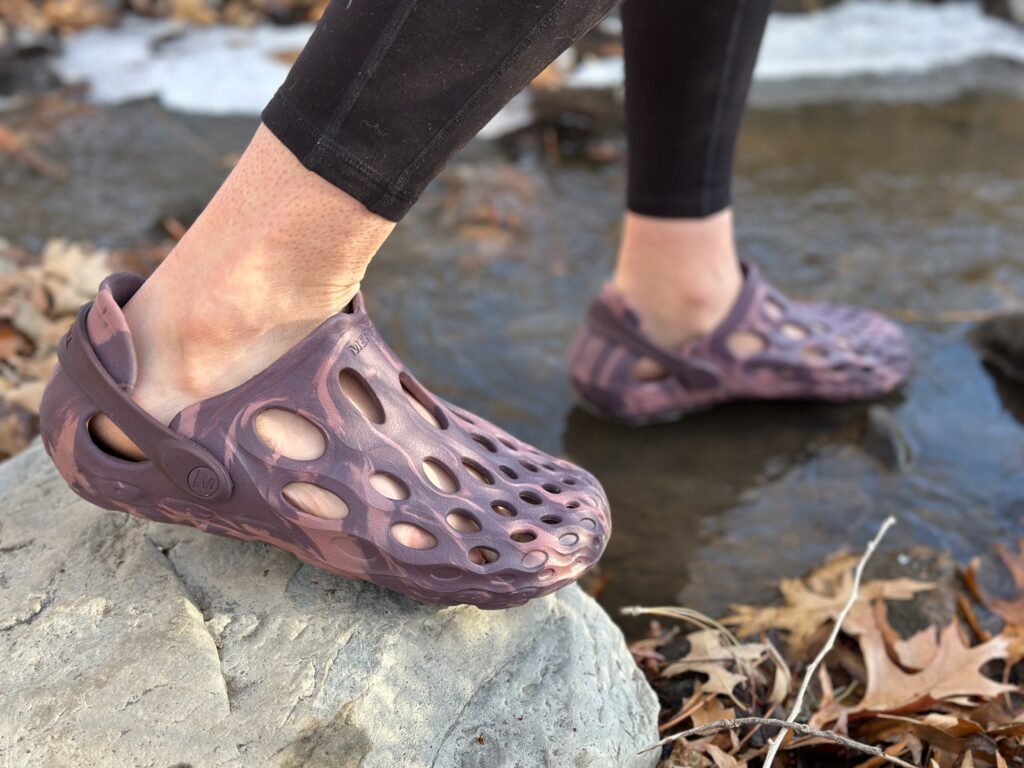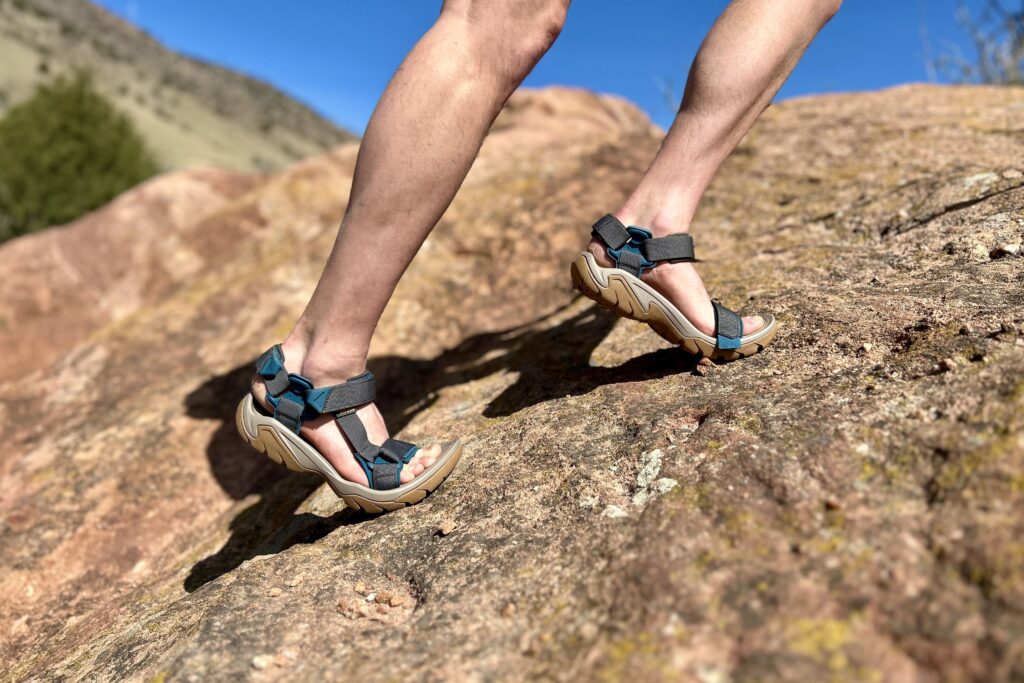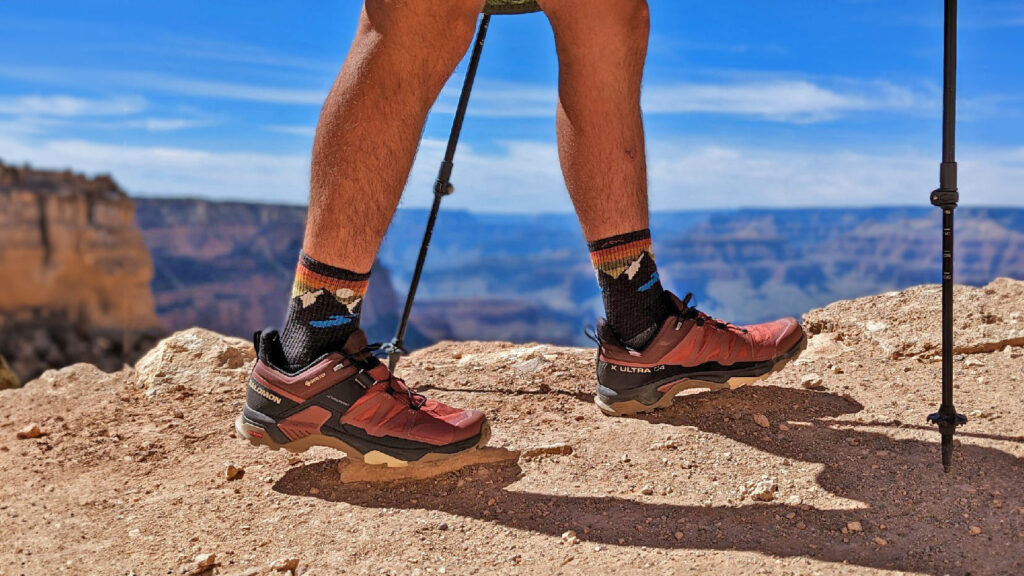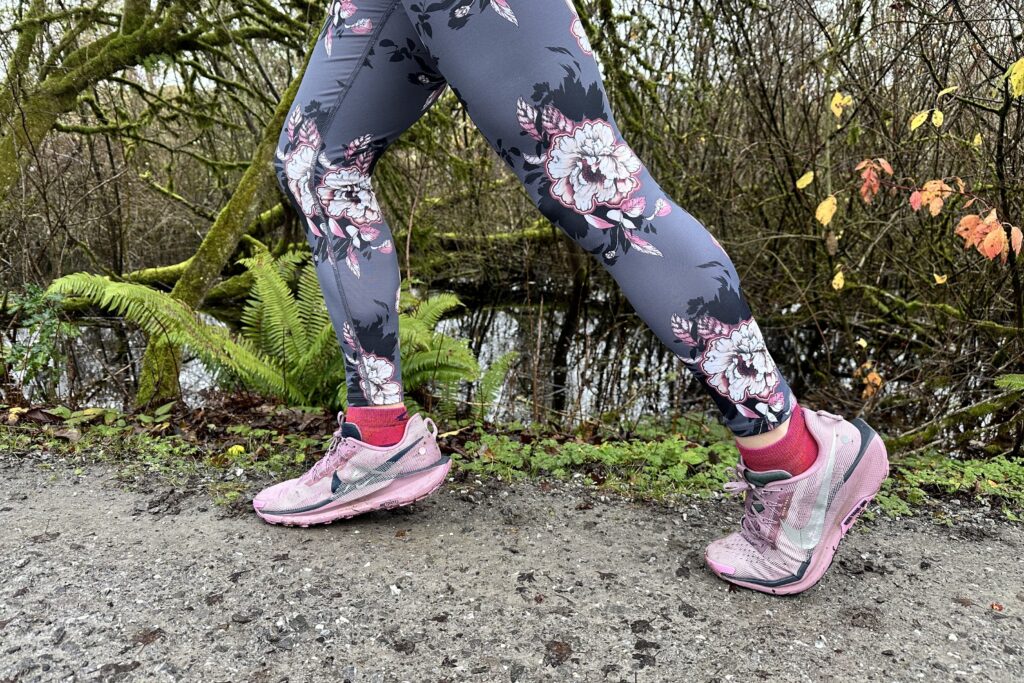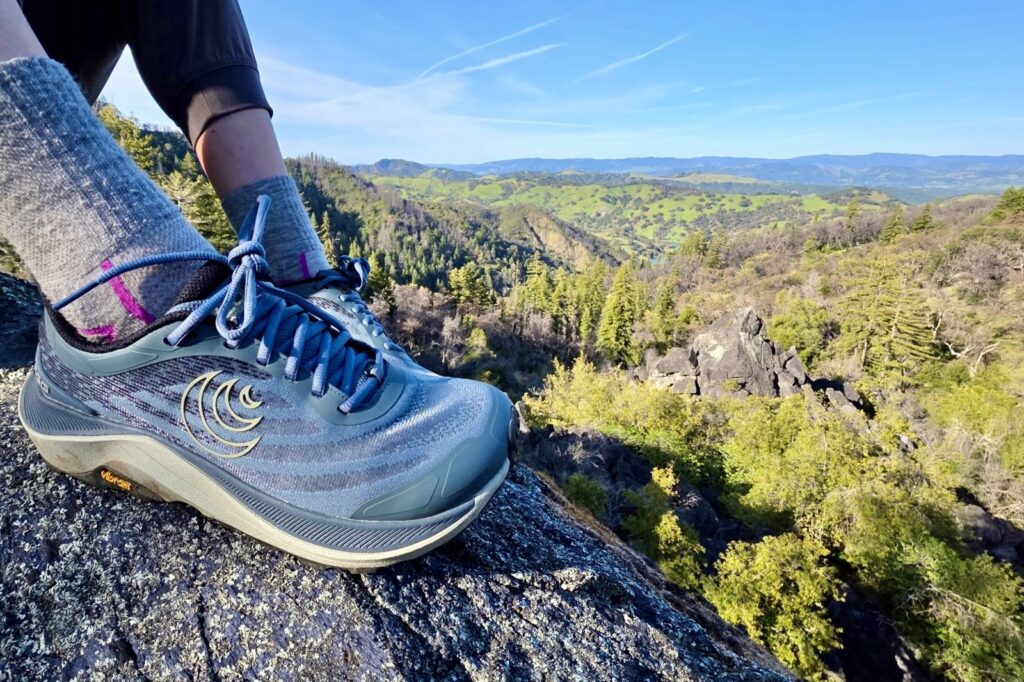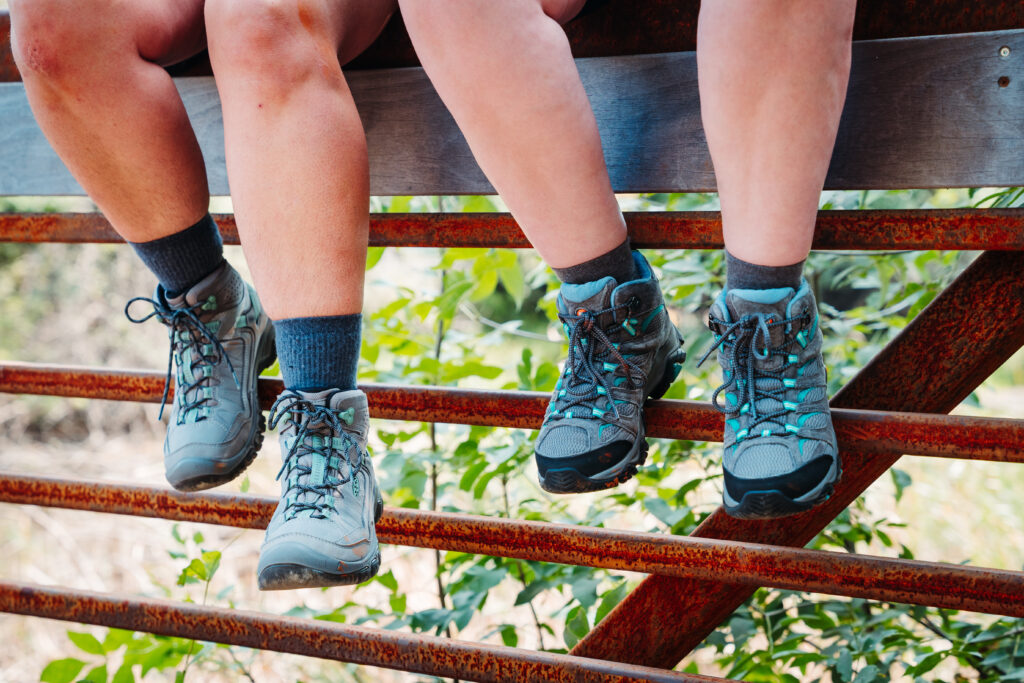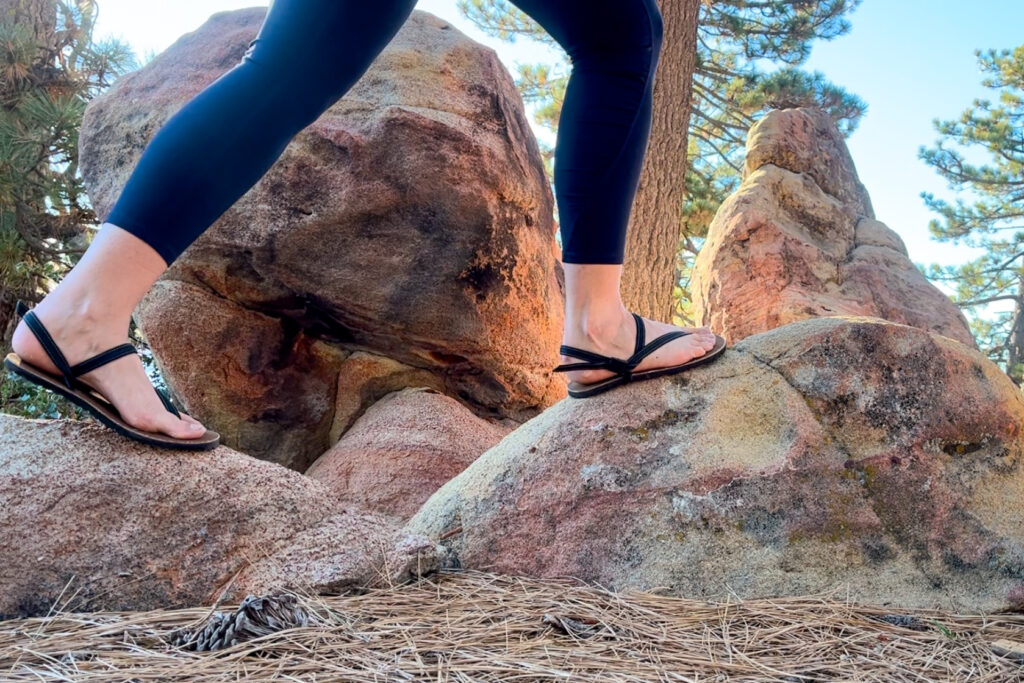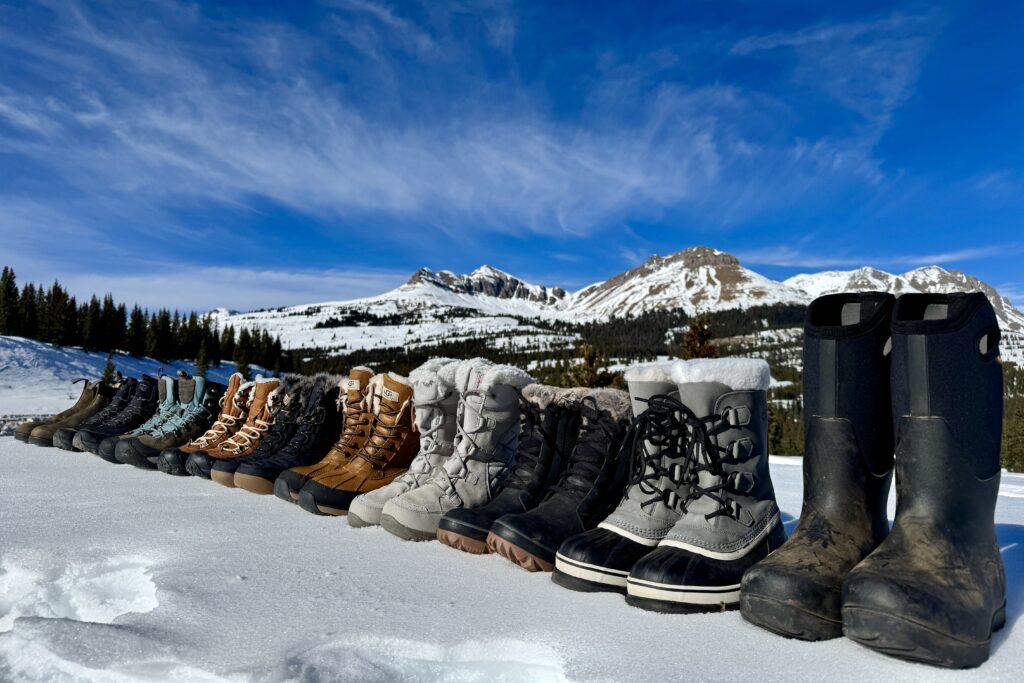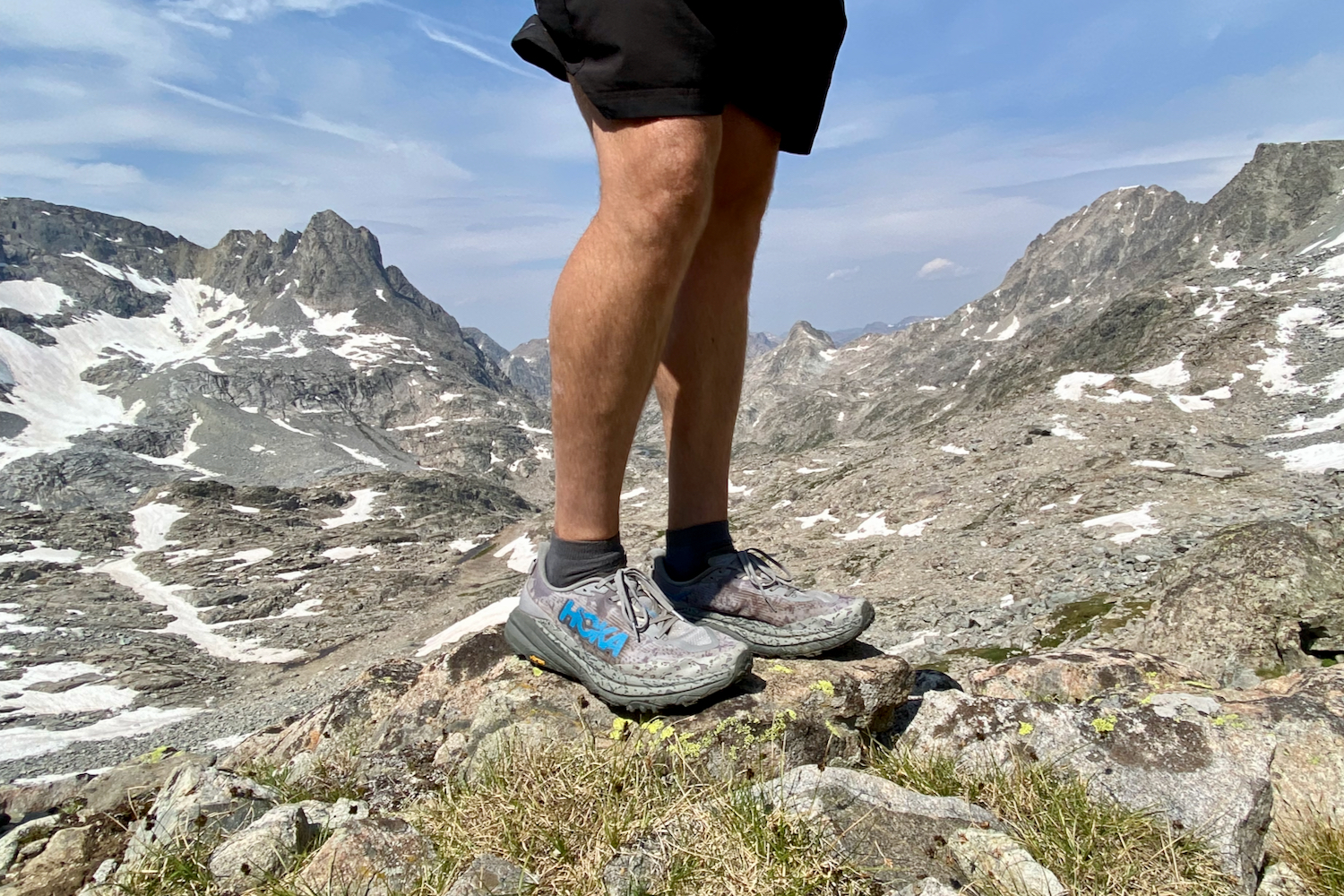
Choosing the right hiking shoes is essential for any adventure. To narrow down your options, focus on key factors like comfort, grip, weight, durability, and resistance to weather conditions.
Our skilled team of hiking experts has tested more than 100 pairs of shoes over the past decade. We tested brands like HOKA, Merrell, Brooks, Altra, and many more.
During our testing, we covered more than 20,000 miles of trails, including short day hikes and extensive thru-hikes on world-renowned trails. These experiences have provided us with valuable insights into what to consider when selecting hiking shoes.
And for more info, check out some of our other most popular gear guides:
Quick Picks for Men’s Hiking Shoes
Check out this list of the best hiking shoes, or continue scrolling to see our full lineup of favorites with in-depth reviews.
Best Hiking Shoes Overall: Salomon X Ultra 5 GTX ($170)
Best Balance of Weight, Support & Breathability: Topo Athletic Ultraventure 4 ($155)
Best Grippy & Comfy Waterproof Hiking Shoes: HOKA Anacapa 2 Low GTX ($180)
Best Lightweight Trail Runners for Long Distances: Saucony Peregrine 15 ($145)
Best Shoe for Fast and Light Missions: La Sportiva Prodigio ($165)
Lightweight and Waterproof Hiking Shoe: Oboz Katabatic LT GTX ($170)
Good Balance of Comfort & Traction: HOKA Speedgoat 6 ($155)
Best Budget Hiking Shoes: Merrell Moab 3 ($140)
Supportive & Comfortable Trail Runners for Long Distances: Brooks Cascadia 19 ($140)
Reliable Pair of Waterproof Hiking Shoes: KEEN Targhee IV ($160)
Best Hiking Shoes for Technical Terrain: La Sportiva Ultra Raptor 2 ($149)
Best Shoe-Boot Hybrid: La Sportiva Spire GTX ($209)
Best Zero Drop Shoes for Thru-Hiking: Altra Lone Peak 9 ($140)
Best for Town to Trail: Danner Trail 2650 ($170)
Men’s Hiking Shoes OVerall Testing Scores
What’s new
Our updated guide includes one new trail running shoe, one new hiking shoe, and updated versions of four shoes we recommended in our last list of the best hiking shoes for men:
- The latest version of a long-time winner, the Salomon X Ultra 5 improves its durability and comfort with its 5th iteration.
- New to our lineup, the La Sportiva Prodigio and Oboz Katabatic LT give hikers more lightweight options.
- The Saucony Peregrine 15 improves its midsole to make it an extremely comfortable yet still lightweight shoe.
- With added durability with TPU overlays, the Topo Athletic Ultraventure 4 is a favorite for its comfort and support for long days.
- A long time favorite in the thru hiker world, the Altra Lone Peak 9 continues to have a strong following among those who love zero drop shoes.
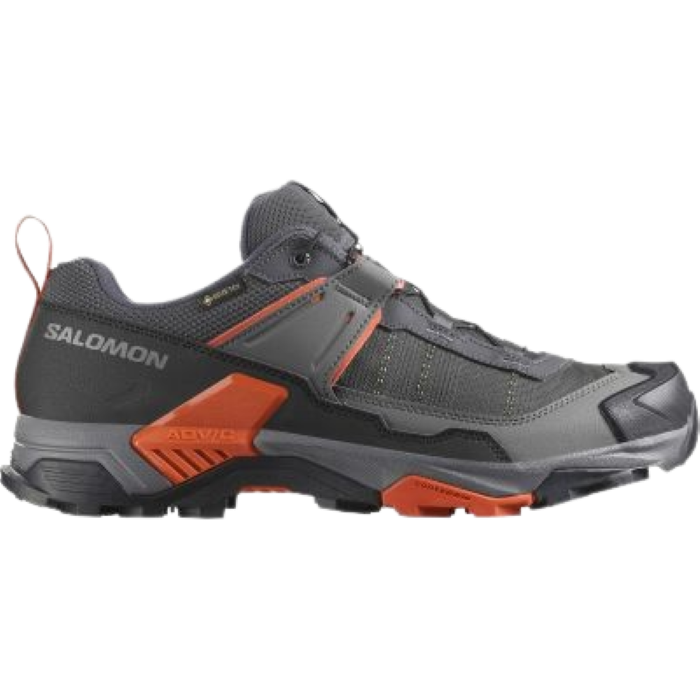
Men’s Salomon X Ultra 5 GTX
Best Hiking Shoes Overall
CleverHiker Rating: 4.8/5.0
Price: $170
Weight (Pair): 1 lb. 11 oz.
Heel-to-Toe Drop: 11 mm
Pros
- Outstanding traction
- Easy-to-use quick lace
- Waterproof
- Stable soles
- Protective toe cap and heel
Cons
- Heavier than some
- Not as flexible as some
- High heel-to-toe drop won' t suit everyone
The Salomon X Ultra 5 GORE-TEX is a burly, waterproof hiking shoe built for rugged adventures in wet and challenging terrain. If stability, durability, and dry feet are your top priorities, this shoe delivers. Tested on off trail traverses in Alaska’s Chugach Range, the X Ultra 5 is one of our top choices for a dependable hiking shoe, no matter the conditions.
The X Ultra 5 is one of the most stable shoes we tested. With a stiff sole and a secure platform, it shines on uneven terrain where support and protection matter most. From steep alpine scrambles to scree-filled traverses, we found it reliable and confidence-inspiring underfoot. Its waterproofing is excellent, making it ideal for wet and cold climates. The GORE-TEX membrane, paired with the thick upper, kept our feet dry through creek crossings, snow patches, and sloppy trails. That same burly upper traps heat, though, so it’s less ideal for hot summer time hikes.
Traction is strong, especially when the footing is loose or muddy. The deep lugs and Contragrip rubber bite into soft terrain and shed debris well. However, we noticed some slip on smooth, wet rock surfaces. Still, it’s one of the grippier shoes in the lineup. Weight is the main trade-off. The X Ultra 5 is heavy compared to sleeker trail shoes, but with that weight comes increased durability and support. This newest version of the X Ultra 5 continues to prove why it is one of our favorite hiking shoes.
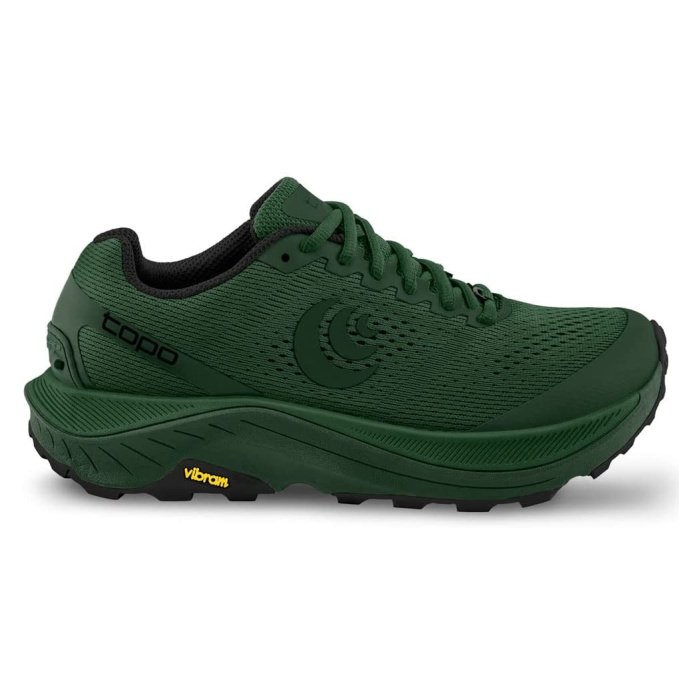
Men’s Topo Athletic Ultraventure 4
Best Balance of Weight, Support & Breathability
CleverHiker Rating: 4.6/5.0
Price: $155
Weight (Pair): 1 lb. 4.8 oz.
Heel-to-Toe Drop: 5 mm
Pros
- Lightweight
- Breathable
- Roomy toe box
- Cushy soles
- Good for wide feet
Cons
- Not as durable as burlier hiking shoes
- Mesh uppers let in dust
- Toe box too wide for some
The Topo Athletic Ultraventure 4 is a supremely comfortable trail running shoe with a wide toe box, plush cushioning, and a lightweight build that makes it ideal for logging big miles on moderate terrain. If comfort and an anatomical fit top your priority list, this shoe delivers in a big way.
The Ultraventure 4 shines in comfort. Its generous midsole cushioning and 5mm drop offer a soft yet stable ride that left our feet feeling fresh after 15+ mile days. Unlike some wide-toe-box shoes, the Ultraventure 4 still holds the foot securely thanks to a snug heel and precise lacing system. It’s especially well-suited to hikers with wider feet or anyone who values a natural foot shape and wants to avoid pinched toes.
Designed for moderate trails and warm weather, the Ultraventure 4 does not offer the highest traction or weather resistance. The open mesh upper is incredibly ventilated and dries fast, but lets in dust and water quickly too. Its shallow lugs and exposed foam outsole are great for dry, well-groomed trails but don’t dig into mud or scree as well as more aggressive shoes. Although it’s not our first pick for rugged or off-trail terrain, it performs well on most established routes.
If you’re looking for a breathable, high-mileage trail shoe that prioritizes comfort and a natural fit, the Topo Athletic Ultraventure 4 is one of the best in the game. It’s not built for technical mountain scrambles or deep mud, but for dry, moderate trails and long summer days, it’s a standout performer.
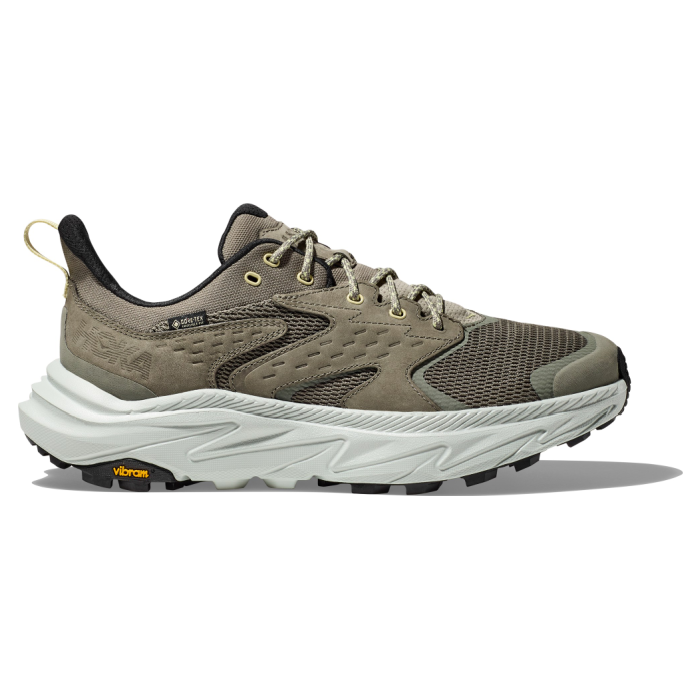
Men’s HOKA Anacapa 2 Low GTX
Grippy & Comfy Waterproof Hiking Shoes
CleverHiker Rating: 4.5/5.0
Price: $180
Weight (Pair): 1 lb. 14.6 oz.
Heel-to-Toe Drop: 8 mm
Pros
- Grippy and sticky lug pattern
- Comfortable midsole
- Laces stay put once tied
- Waterproof
- Excellent weather resistance
- Rockered design for a natural gait
Cons
- Expensive
- Too wide for some
- Heavier than other shoes
- Dovetail heel takes getting used to
- Aesthetic won't fit everyone's style
The HOKA Anacapa 2 Low GTX is a unique blend of comfort and durability, making these shoes an excellent choice for both day hikes and extensive backpacking trips. With a sole just stiff enough for steep ascents and a wider toe box to let your forefoot spread out, they feel comfortable and supportive on most terrain and trail conditions.
The uppers are decently durable – and stronger than other models we tested – thanks to a combination of leather and mesh, and the TPU toe cap adds a bit of extra protection.
HOKA offers solid traction on this model, with a chunky lug pattern that bites the ground for excellent grip on rocks and roots. The Gore-Tex liner gives reliable waterproofing in wet conditions, and a rockered heel makes them outstanding for daily use in a variety of trail conditions, whether you’re on the third day of a muddy route or tackling a local trail in wet conditions.
But, for the price, the Anacapa 2 is one of the most spendy pairs of shoes on this list. Because of its wider fit, HOKA’s extended heel, and unique aesthetic, we found the Anacapa’s might take a bit of time to get used to.
Though they are a bit more expensive, the HOKA Anacapa 2s offers top-tier comfort and durability. If you need a new go-to waterproof hiker with great support and protection for 3-season hiking, these are worth a closer look.
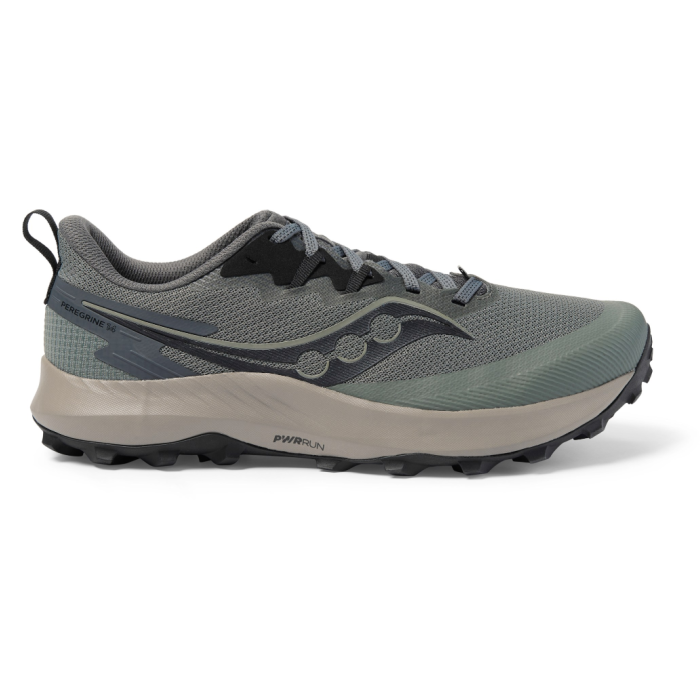
Men’s Saucony Peregrine 15
Best Lightweight Trail Runners for Long Distances
CleverHiker Rating: 4.4/5.0
Price: $145
Weight (Pair): 1 lb. 2.4 oz.
Heel-to-Toe Drop: 4 mm
Pros
- Excellent traction
- Breathable mesh uppers
- Lightweight
- Less expensive
- Flexible outsoles
- Rock plate protects arches
- No break-in period
Cons
- Not as durable as classic hiking shoes
- Limited cushioning
- Few protective features
- Laces wear out faster than prior version
From long treks through Nepal’s Himalayas to Patagonia’s famous Torres del Paine, our team at CleverHiker has hiked thousands of miles in Saucony Peregrines over many years. These shoes are grippy and lightweight.
The Peregrine 15s are nearly identical to the prior version of this shoe except for the lacing harness. Saucony swapped out round laces for flat ones and added more cushioning through the tongue. The result is a shoe that feels nearly as spry, flexible, and responsive as before. Although, this change is very small, so most hikers won’t notice much of a difference.
These shoes’ mesh uppers breathe exceptionally well and dry quickly, so they’re a solid all-around option for almost any summer conditions, rain or shine, desert or mountains. The sizing and fit are true-to-size and consistent. We like that the lacing and tongue allow the shoe to fully tighten around the foot from heel to toe, feeling secure and locked down underfoot.
This shoe also stands out for its knobby, triangular lug pattern. The chunky grip provides reliable traction from sandy coastal trails to rocky alpine routes. We like the bit of extra cushioning that allows the Peregrine 15 to walk a fine line between agility and support.
The Peregrine 15 is a trail runner designed for fast, lightweight movement over long periods of time, so they don’t have hiking-specific features like a toe cap, dovetail heel, or reinforced uppers. The combination of mesh, TPU, and ultralight foams and rubbers means they won’t last as long as beefier shoes on this list like the La Sportiva Spire or the HOKA Anacapas.
That said, weighing only 10.5 ounces per shoe, these classic Saucony trail runners are a great option. If you’re looking for lightweight, comfortable shoes for your next weekend backpacking trip or footwear that can carry you across the continent, the Peregrine 15 is up to the task.
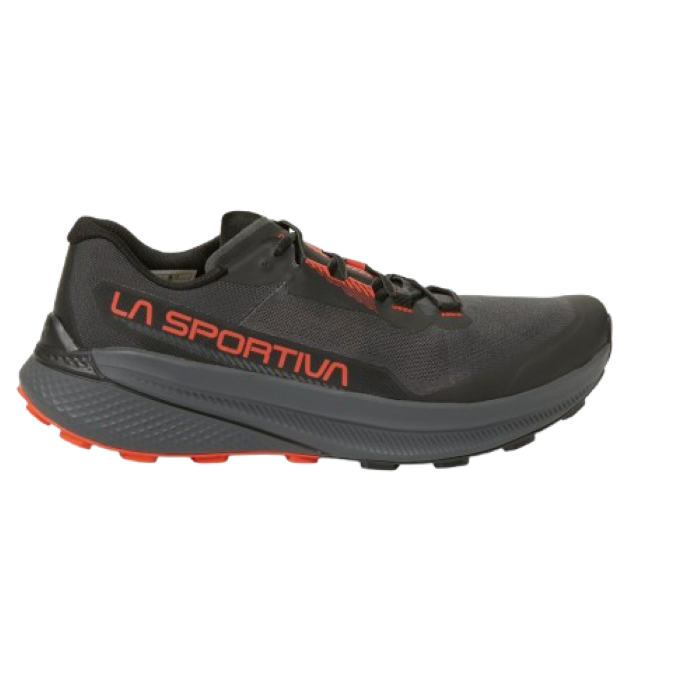
Men’s La Sportiva Prodigio
Best Hiking Shoe for Fast & Light Missions
CleverHiker Rating: 4.5/5.0
Price: $165
Weight (Pair): 1 lb. 3 oz.
Heel-to-Toe Drop: 6mm
Pros
- Great traction
- Durable for a trail runner
- Performance fit
- Lightweight
Cons
- Not a good fit for wide feet
- Stiff ankle collar can be uncomfortable
- Tricky sizing
The La Sportiva Prodigio is a lightweight, high-performance trail running shoe built for moving fast over rugged terrain. Designed with a precision fit and a focus on technical movement, it’s a top pick for runners and mountain enthusiasts who value speed, stability, and reliable traction above all else.
The Prodigio delivers serious grip and support in challenging conditions. The strong rubber outsole and aggressive 4mm lugs excel on everything from loose dirt to slick rock. The dual-density rubber is soft on the inside for grip and firmer on the outside for durability. Its rockered profile allows for a comfortable gait, and the midfoot wrap system helps maintain control on off-camber terrain. We love the welded overlays and a robust toe cap for boosting protection without adding much bulk or weight.
This shoe is not for everyone, but it’s exceptional for the right user. The narrow fit and firm midsole create a snug, performance-oriented feel. However, that fit may be uncomfortable for wider feet or casual hikers. We suggest sizing up a half size and giving it some break-in time. The stiff and minimally padded ankle collar softened with wear but caused some discomfort early on.
The Prodigio is impressively light, durable, and trail-ready. After 50+ miles in the Chugach Range, including talus-hopping, ridge scrambling, and fast scree descents, it’s proven itself as one of the most capable shoes for high-output days in the mountains.
More: Prodigio Full Review
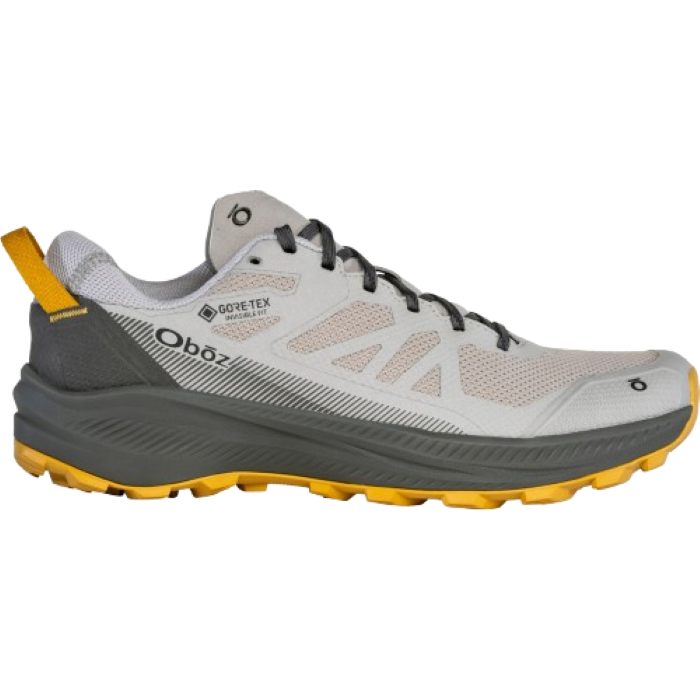
Oboz Katabatic LT Low GTX
Lightweight and Waterproof Hiking Shoe
CleverHiker Rating: 4.5/5.0
Price: $170
Weight (Pair): 1 lb. 7 oz.
Heel-to-Toe Drop: 8mm
Pros
- Lightweight for a hiking shoe
- Comfortable
- Good stability
- Grippy across a wide range of terrain
- Waterproof
Cons
- Narrow forefoot and toe box
- Not the most breathable
- Expensive for a fully synthetic shoe
The Oboz Katabatic LT Low GTX is a trail-running–inspired hiking shoe that delivers agility and dependable waterproof protection in one lightweight package. Built upon a responsive foam midsole and integrated rock plate, the Katabatic soaks up sharp impacts on rocky ground while preserving a “barely there” feel underfoot—ideal for fast-moving hikers who prioritize speed and comfort over a bulky boot. Right out of the box, the synthetic upper and low break-in period meant our testers were logging double-digit miles without hotspots, and the narrow heel pocket locked the foot securely in place during quick direction changes.
Underfoot traction is confident on both wet and dry surfaces: the multi-directional lugs stuck to slabby granite in Colorado and shed mud on spring hikes in Maryland, though late-spring snow and ice occasionally caught us off guard (as we’d expect from a shoe not specifically made for winter conditions). The built-in GORE-TEX Invisible Fit membrane stood up admirably to puddles, creek crossings, and slushy “second winter” conditions. It kept our feet dry without stifling breathability. After several hours of constant moisture, we noticed slight seepage at mesh seams, reminding us this isn’t a substitute for a high-cut hiking boot.
Durability has been impressive. Several hundred miles later, there are only minor scuffs on the uppers and minimal outsole wear, with no heel separation or midsole compression. However, hikers with wider feet or those who wear thick winter socks may find the forefoot snug, and the price point is on the higher end for a synthetic shoe.
More: Katabatic LT Full Review
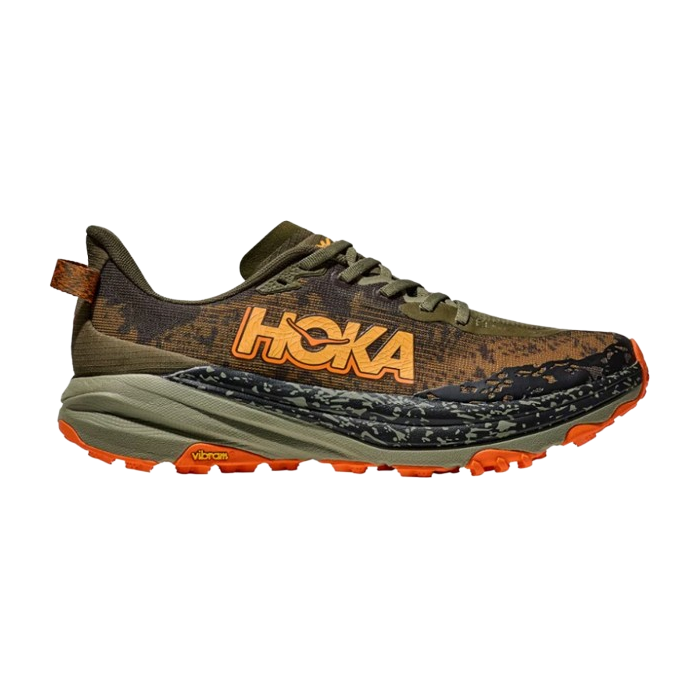
Men’s HOKA Speedgoat 6
Good Balance of Comfort & Traction
CleverHiker Rating: 4.3/5.0
Price: $155
Weight (Pair): 1 lb. 3.6 oz.
Heel-to-Toe Drop: 5 mm
Pros
- Cushy soles
- Excellent traction
- Great arch support
- Lightweight
- Roomy toe box
- Breathable
- No break-in needed
Cons
- Uppers and midsoles less durable than some
- Stiffer midsoles than prior versions
- Toebox not as wide as prior versions
- Dovetail heel may take getting used to
The HOKA Speedgoat 6 offers an excellent combination of comfort, support, and weight savings. The Speedgoats have ranked on our list for years thanks to thick, soft midsoles, which make for a comfortable ride. Though stiffer than the 5s, they still provide ample impact absorption, so you won’t feel those branches, rocks, or roots while moving down the trail.
Weighing in at only 9.8 ounces each, these are some of the lightest shoes in our lineup, but they don’t skimp on important features. There’s sufficient room in the toe box (they also come in wide), and the outsoles have a lug pattern that provides outstanding traction, especially on the ups. The Speedgoat’s laces stay put once tied, the uppers are impressively fast-drying and breathable, and these shoes are pleasant and snug right out of the box.
Like many trail runners, the Speedgoats are not built for durability. Although the uppers last longer than many other trail runners, the foam soles are prone to damage and tend to wear out faster than burlier trail shoes. That said, we hiked 200 miles in the Speedgoats before they began to show wear and tear.
The Speedgoats also have a reduced heel flare from the back of the shoe, which contributes to the shoe’s slightly rockered soles our team likes so much. Plus, the Speedgoats come in cheerful, kaleidoscopic colorways, so they are a great choice for hikers and runners who don’t shy away from bold colors.
The Speedgoat 6 leads the pack as a cushioned, extremely lightweight trail runner. If a supportive build, über-cushy feel, and great traction are your top priorities in a hiking shoe, these are a superb option for most feet.
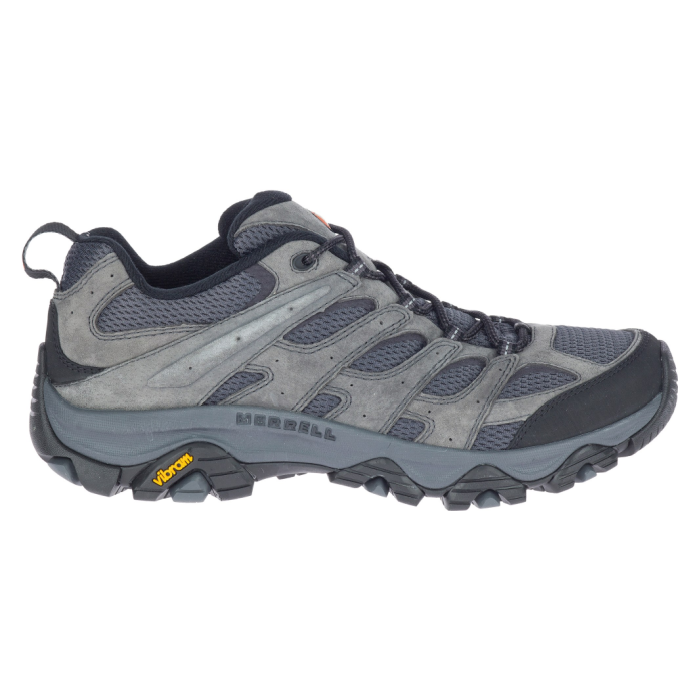
Men’s Merrell Moab 3
Best Budget Hiking Shoes
CleverHiker Rating: 4.2/5.0
Price: $140
Weight (Pair): 1 lb. 9.1 oz.
Heel-to-Toe Drop: 11.5 mm
Pros
- Less expensive
- Very little break-in needed
- More durable than trail runners
- Breathable mesh
- Excellent traction
- Laces hold well
- Dry fast for hiking shoes
Cons
- Heavier than some
- Not as flexible as trail runners
- Bulkier outsole than trail runners
The wildly popular Merrell Moab 3 has been our top budget shoe pick for years. These shoes are comfortable, versatile, and an outstanding value. These fan favorites offer similar protection to a hiking boot in a breathable, low-profile shoe with next to no break-in period necessary.
These shoes are a rare combination of comfort and ventilation, thanks to their non-waterproof construction. They also come in a waterproof version, although we prefer the non-waterproof shoes because they offer better ventilation for wet or sweaty feet and on warm days. That said, we are big fans of the waterproof boot for soggy and muddy hikes, and we named them the best budget hiking boots in our Best Hiking Boots for Men Guide.
Aesthetically, the Moab 3s are about as traditional-looking as hiking shoes come: all the colorways are earth tones, the profile is burly, and the leather and mesh combination is reminiscent of old-school boots.
Though the Moabs aren’t the sleekest or lightest shoes on the market, they are comfortable. The insoles are contoured with thick heel cushioning, the midsole is soft but firm, and the outsoles offer decent traction on most surfaces, while still feeling durable. The thick toe and heel guards protect your feet from the trail, so you’ll barely notice brambles and sharp rocks. We also like the Moab’s long laces because they’re easy to tie, cinch the shoe tightly around our feet, and don’t need constant adjustments.
Compared to many other shoes on this list, these are on the bulkier and heavier side, so we tend to leave them at home for long backpacking trips and huge hiking days. However, we highly recommend the Moab 3s for just about any other hiking adventure. For weekend warriors, summer hikers, and folks who prioritize comfort on short overnight trips and day hikes, the Moab 3 might just be your glass slipper.
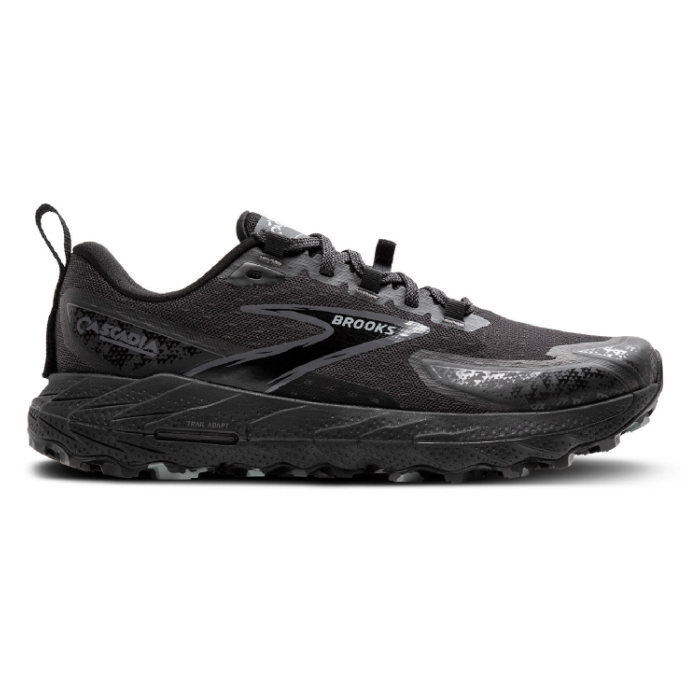
Men’s Brooks Cascadia 19
Supportive & Comfortable Trail Runners for Long Distances
CleverHiker Rating: 4.1/5.0
Price: $140
Weight (Pair): 1 lb. 7.3 oz.
Heel-to-Toe Drop: 6 mm
Pros
- Cushioned heel and midsole
- Versatile for road and trail running
- Large heel tab
- Flexible uppers
- Less expensive
Cons
- Laces get stiff over time
- Mesh uppers blow out
- Less ground feel than other trail runners
The Brooks Cascadia 19s are versatile, breathable trail runners well-suited for covering huge mileage days on established trails. We have tackled over 6,000 miles of America’s most scenic trails in these shoes, including thru-hikes of the PCT, CDT, Pinhoti Trail, and more. Whether you’re a trail runner, day hiker, or long-distance backpacker, these are comfortable trail shoes that feel fast on backcountry routes.
Cascadia 19s weigh 11 ounces per shoe – lighter than traditional hiking shoes. These are first and foremost trail runners, so they aren’t designed for off-trail adventures. That means Cascadia 19s don’t have the durability of hiking-specific shoes on this list. We noted a hole in the toe after 200 miles and tread wearing out around 300 miles. With a 6-millimeter heel-to-toe drop, this has a traditional trail runner build, which won’t appeal to low-drop or zero-drop fans.
Still, we like the Cascadia 19s for their consistent all-around performance – these are a bullseye for dependable shoes with almost no break-in period. Whether you’re thru-hiking the North Country Trail or just romping around your local backcountry routes, these trail runners are tough to beat.
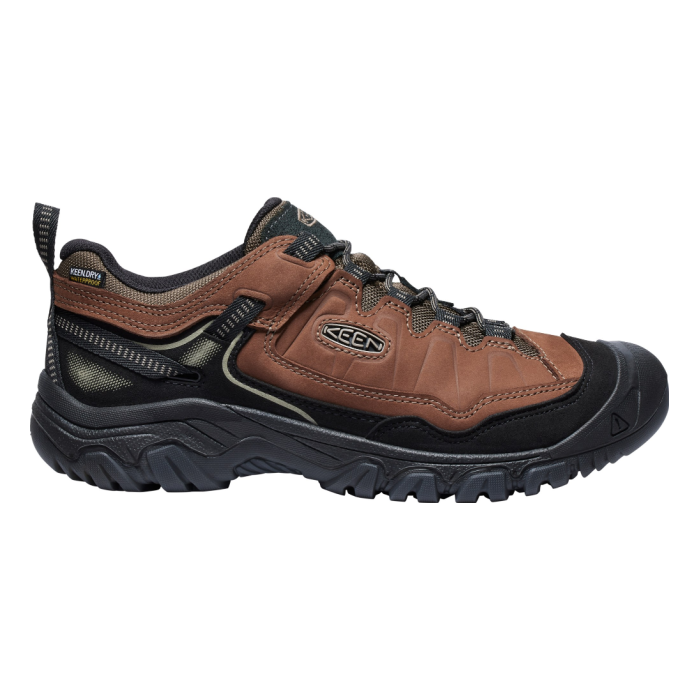
Men’s KEEN Targhee IV WP
Reliable Pair of Waterproof Hiking Shoes
CleverHiker Rating: 4.0/5.0
Price: $155
Weight (Pair): 2 lb. 6.4 oz.
Heel-to-Toe Drop: 14 mm
Pros
- Durable construction
- Roomy toe box
- Secure lacing system
- Stable
- Waterproof
- Comfortable once broken in
Cons
- Heavier than some
- Stiff soles
- Longer break-in period
- Bulkier profile
- High heel-to-toe drop
The KEEN Targhee IV WP is a crowd-pleaser: these shoes are dependable and roomy. These all-leather hiking shoes demand a longer break-in time than many of the lightweight models on our list, but the pliable leather is reliable and durable, and the strong build quality means they’ll hold up for hundreds of miles. And, once they’re broken in, you’ll enjoy hundreds of miles of supportive, satisfying hiking.
A protective toe cap extends completely over the top of the shoe to keep your toes safe from sharp rocks. Although the lugs are a bit shallow and wide compared to other leather shoes on this list, the multi-directional traction pattern and wide outsole still felt grippy and stable, making even the roughest trails feel smooth. Double-stitched leather panels run the length of the shoe along the outsole to add more durability.
One of our favorite features of the Targhee IV is a sturdy band that connects the laces to the heel cup. This helps provide a secure, locked-in feeling and makes it easier to dial in the perfect fit. They are also known for their wide toe box, so they’re an excellent choice for hikers needing a little extra wiggle room in their shoes.
Because they’re on the bulkier side, we recommend them for shorter adventurers, cooler-weather days, and hikers who want comfortable daily wear.
We’re big fans of the Targhee IV shoes. For hikers seeking roomy, comfortable, waterproof footwear that will last for multiple seasons, you won’t regret picking up a pair of these KEENs.
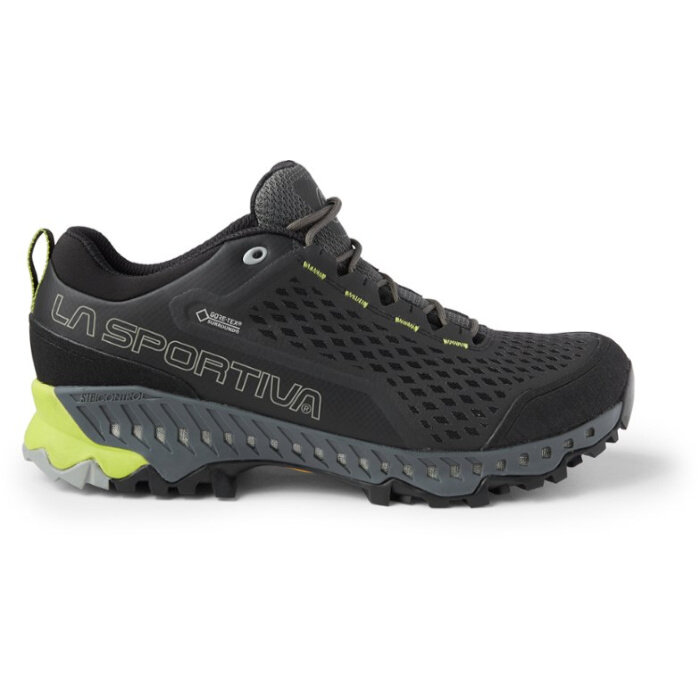
Men’s La Sportiva Spire GTX
Best Shoe-Boot Hybrid
CleverHiker Rating: 4.0/5
Price: $209
Weight (Pair): 1 lb. 15 oz.
Heel-to-Toe Drop: 6 mm
Pros
- Quality construction
- Breathable
- Waterproof
- Stable
- Great traction
- Snug fit
Cons
- Expensive
- Heavier than some
- Stiff soles
- Medium break-in period
- Runs narrower than some
- Flimsy shoelaces
The La Sportiva Spire GTX is a seriously burly shoe. It effectively mixes the stability, deep lugs, and waterproofing of a classic hiking boot with the comfort, breathability, and low profile of a trail runner. These are the perfect shoes if you love the feel of a hefty hiking boot but want a slightly more flexible and versatile waterproof option for shoulder season adventures or wet, muddy trail conditions.
The stiff midsole and aggressive Vibram outsoles are protective and grippy, and the quality build La Sportiva is known for means these puppies will last for hundreds of miles. But, these shoes will require a longer break-in period before they really shine. Once you’ve gotten through that initial break-in, the secure fit feels stable and comfortable.
The Spires also have a higher heel-to-toe drop of 11 mm. That’s great if you love traditional heel cushioning and foot support. However, if you like a lower profile or more natural foot strike, these might feel a bit too tippy and tall to keep a natural gait.
When shoes are waterproof, they usually aren’t very breathable. The opposite is true with the Spires: the waterproof liner keeps out snow, rain, and snow while aeration channels in the footbed and midsole help release more moisture vapor. Our feet also stayed consistently dry and comfortable on days up to 70 degrees.
They weigh in at about one pound per shoe. This is in large part due to the beefy midsole and thick synthetic upper. Those elements inspire confidence off-trail and in gnarly mud or light snow but make the shoes feel hot and heavy for summer hiking on groomed trails.
These shoes are one of the more expensive pairs on our list. However, they are well worth the price if you’re looking for a waterproof hiking shoe for day hikes, weekend adventures, and section hikes where weatherproofing and durability matter.
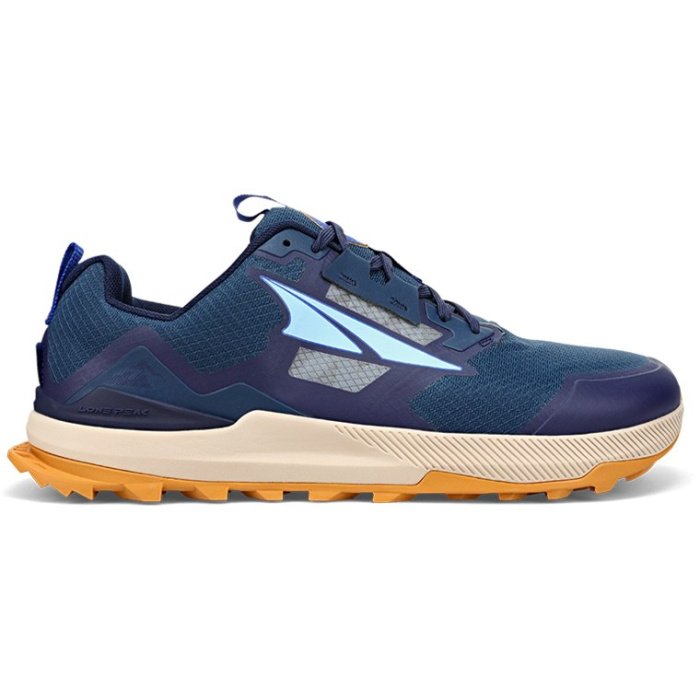
Men’s Altra Lone Peak 9
Best Zero Drop Shoes for Thru-Hiking
CleverHiker Rating: 3.7/5.0
Price: $140
Weight (Pair): 1 lb. 5.4 oz.
Heel-to-Toe Drop: 0 mm
Pros
- Roomy toe box
- Excellent traction
- Lightweight
- Flexible outsoles
- Breathable uppers
- Rock plate
- No break-in needed
- Built-in gaiter attachment
Cons
- Not as durable as some
- Zero drop doesn't work for everyone
- Lacing system is a bit cumbersome
- Thinner soles
- Not weather resistant
If you love hiking and backpacking, chances are you’ve encountered one of the most popular pairs of trail-running shoes out there, the Altra Lone Peak 9. These zero-drop shoes offer outstanding traction, a natural foot shape, and a ton of room in the toe box.
They are foot-shaped, so they’re snug and comfy through the midsole and heel, but very wide in the toebox. In fact, the toebox is one of the largest on this list, offering a ton of room for your forefoot and toes to splay out naturally for an ergonomic gait.
Altra’s signature Trail Claw lug pattern offers a variety of square, triangular, and ribbed lugs across the outsole for ultra-tacky, super-effective traction in most trail conditions. The Lone Peak 9s also have great ground feel, allowing for better navigation of the trail with every step -whether you’re traversing sandstone washes in the deserts of Arizona or hiking over tall mountain passes in the Sierra Nevada.
This is one of our top picks for hot weather and trails that are wet, mucky, or overgrown. With lightweight mesh uppers, they dry in no time. The large Velcro gaiter attachment at the heel (gaiters sold separately) is perfect for keeping out brambles, dirt, and rocks.
For many folks, zero-drop shoes promote a natural foot position and can even help solve foot and leg pain. However, zero-drop shoes are not for everyone. We always recommend researching and testing if zero-drop shoes will work for your biomechanics.
The biggest downside of these shoes is their lower durability. Due to their lightweight uppers, the Lone Peak 9s won’t last as long as more durable, heavier options. That also means they’re too light and thin to offer much protection from water or inclement weather, so we don’t recommend them for especially wet or cold routes.
That said, Altra hits the nail on the head when it comes to a wide toe box, burly traction, and a comfy, lightweight build. The Lone Peak 9 is the reigning champion of the zero-drop world for good reason, and this pair could become your favorite too.
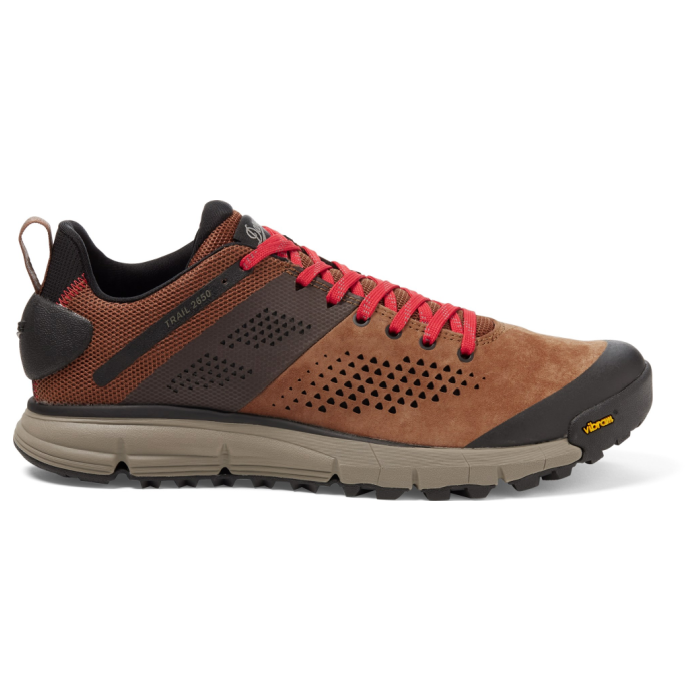
Men’s Danner Trail 2650
Best Hiking Shoes for Town to Trail
CleverHiker Rating: 3.5/5.0
Price: $170
Weight (Pair): 1 lb. 8 oz.
Heel-to-Toe Drop: 8 mm
Pros
- Stylish
- Lightweight
- Outstanding traction
- Soft insole
- Comfortable out of the box
- Breathable
- Protective heel & toe guard
- Excellent lacing system & long laces
- Large heel tab
Cons
- Suede / leather uppers dry very slowly once wet
- Uppers not as durable as other shoes
- Runs a bit narrow
- Tread not effective on wet surfaces
- Thinner foam midsole can feel uncomfortable on long miles
Whether you’re thru-hiking the Pacific Crest Trail or need a stylish pair of shoes for work, the Danner Trail 2650s can do it all. Featuring brushed leather or suede, clean lines, and a retro aesthetic, we found the Trail 2650s are not just about looks: these shoes get it done on trail as well.
They offer excellent traction, a burly toe and heel guard for on-trail protection, and out-of-the-box comfort. They have a cushioned, responsive feel that makes them super comfy out of the box while lending plenty of support and stability to backcountry adventures. Plus, the 2650s come in lightweight mesh, waterproof, and mid-height versions, so you can find the perfect shoe for your next hike, whether you’re wandering through Utah slot canyons or the rocky and lush Vermont Long Trail.
These are the rare shoes that can transition from a sit-down dinner or matinee at the movies to a backpacking trip or technical day hike.
The 2650s run narrow, so you may need to size up to a wide version. The chunky lug pattern offers great grip on rocks and roots, though the midsole cushioning is a bit thin compared to other hiking shoes. They are spendy, and the leather and mesh of the uppers are not especially durable – and take a long time to dry out once they’re wet, so you may want to save these for dry conditions. These shoes have a medium break-in period, so be sure to wear them out and about a few times before your first long walk in the woods.
Overall, the Danner Trail 2650s are sleek, high-performance hiking shoes that blend retro style with the functionality and comfort of a lightweight trail runner. For hikers looking for a comfortable shoe that can take you from coffee shop to mountain top, consider this pair.
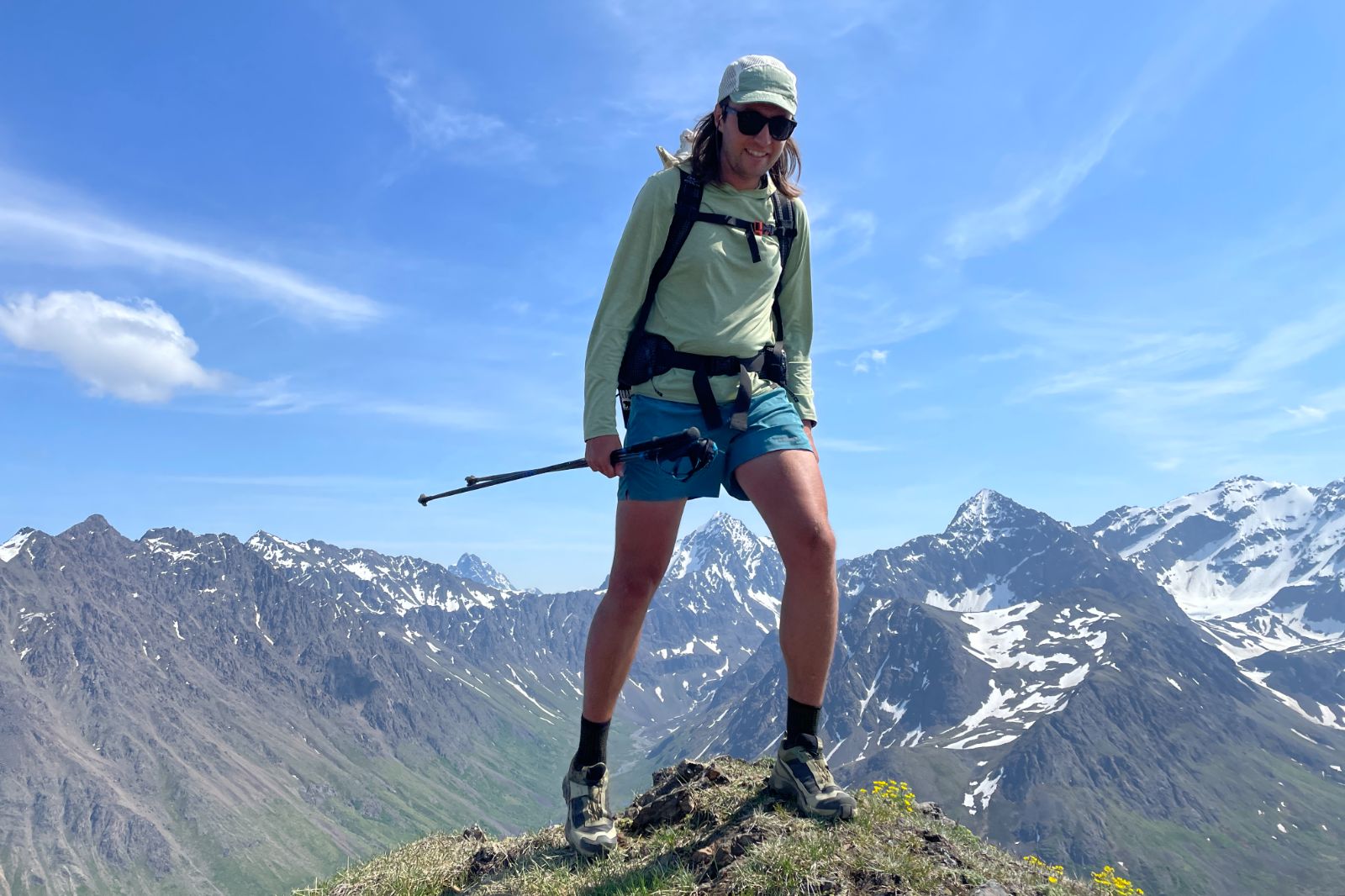
Product Comparison Table
| oSort | Product | Price | Weight (Pair) | Heel-to-Toe Drop | Comfort | Traction | Durability | Weight Score | Weather Resistance | 0 |
Salomon X Ultra 5 GTX View at REI View at Amazon |
$170 | 1 lb. 11 oz. | 11 mm | 4.5 | 4.7 | 4.7 | 4.2 | 4.8 | 1 |
Topo Athletic Ultraventure 4 View at REI View at Amazon |
$155 | 1 lb. 4.8 oz. | 5 mm | 4.8 | 4.3 | 4.4 | 4.7 | 4.2 | 2 |
HOKA Anacapa 2 Low GTX View at REI View at Amazon |
$180 | 1 lb. 14.6 oz. | 8 mm | 4.5 | 4.5 | 4.4 | 3.5 | 4.7 | 3 |
Saucony Peregrine 15 View at REI View at Amazon |
$145 | 1 lb. 2.4 oz. | 4 mm | 4.4 | 4.3 | 3.7 | 4.9 | 3.7 | 4 |
La Sportiva Prodigio View at REI View at Backcountry |
$165 | 1 lb. 3 oz. | 6mm | 4.4 | 4.7 | 4.6 | 4.8 | 4.4 | 5 |
Oboz Katabatic LT Low GTX View at REI View at AMAZON |
$170 | 1 lb. 7 oz. | 8mm | 4.4 | 4.5 | 4.5 | 4.6 | 4.6 | 6 |
HOKA Speedgoat 6 View at REI View at Amazon |
$155 | 1 lb. 3.6 oz. | 5 mm | 4.4 | 4.5 | 3.7 | 4.8 | 3.6 | 7 |
Merrell Moab 3 View at REI View at Amazon |
$140 | 1 lb. 9.1 oz. | 11.5 mm | 4.7 | 4.6 | 4.3 | 3.9 | 4.3 | 8 |
Brooks Cascadia 19 View at REI View at Amazon |
$140 | 1 lb. 7.3 oz. | 6 mm | 4.1 | 4.2 | 4.1 | 4.2 | 3.9 | 9 |
KEEN Targhee IV WP View at REI View at Backcountry |
$155 | 2 lb. 6.4 oz. | 14 mm | 4.6 | 4.6 | 4.2 | 4.0 | 4.1 | 10 |
La Sportiva Spire GTX View at Amazon View at Backcountry |
$209 | 1 lb. 15 oz. | 6 mm | 4.0 | 4.7 | 4.7 | 3.3 | 4.4 | 11 |
Altra Lone Peak 9 View at REI View at Amazon |
$140 | 1 lb. 5.4 oz. | 0 mm | 4.2 | 4.2 | 3.6 | 4.4 | 3.5 | 12 |
Danner Trail 2650 View at REI View at Amazon |
$170 | 1 lb. 8 oz. | 8 mm | 4.1 | 4.0 | 3.8 | 4.0 | 3.3 |
|---|
How We Test & Methodology
We assess hiking shoes in five different dimensions: comfort, traction, weight, durability, and weather resistance. We take out each pair for hundreds of miles on long-distance thru-hikes as well as dozens of day hikes in alpine zones.
COMFORT
Everyone’s feet are different. However, comfort is the most critical feature of any footwear so it’s important to have shoes that feel good. To assess comfort, we look at the amount of room in the toe box – enough for toes to splay naturally but not so much that they feel sloppy; cushioning in the insole and support around the arch. We also consider flexibility at the mid-foot (enough to keep your natural gait), and protection on rocky and rooty trails.
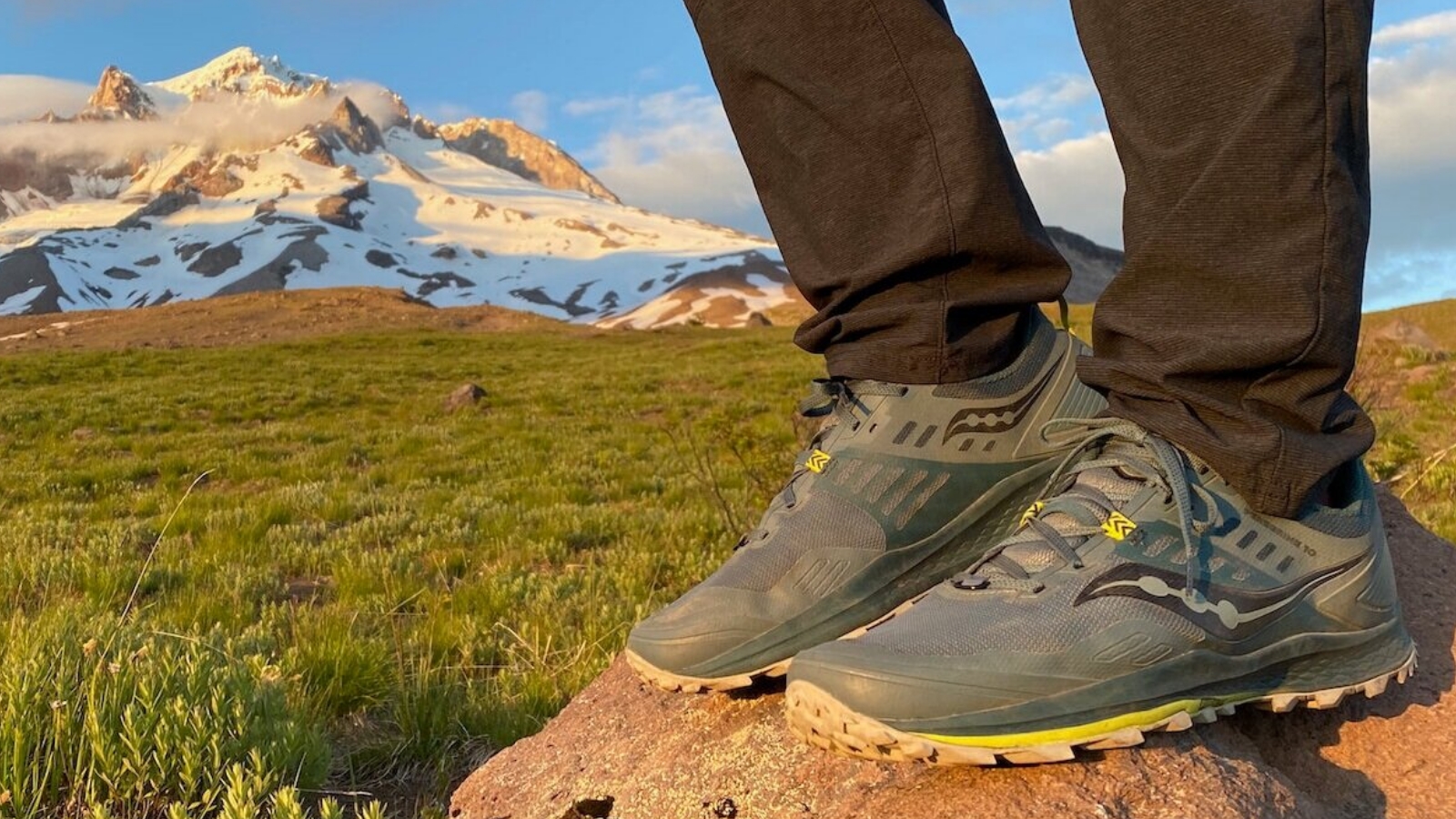
TRACTION
For traction, we examine the lug pattern and depth of the outsole, analyzing during real-world trail testing how effectively it grips on multiple surfaces including, regular dirt, loose soil, mud, wet rock, roots, and sand. We also scrutinize the lug pattern’s design, noting how effectively each model sheds (or cakes) water and debris. Additionally, we consider the type of outsole material, whether it’s a durable rubber or proprietary compound, and its tackiness and flexibility under foot.
WEIGHT
Weight is straightforward – the weight on your feet zaps about five times more energy than the same amount carried on your back. Lighter shoes are always better in this metric and we put each pair on a scale to make sure they measure up.
DURABILITY
For durability, we meticulously examine the outsole material, evaluating its resilience to abrasion and wear over extended use. For the upper material, we scrutinize its robustness against blowouts and tears over time in high-wear areas. We note any reinforced areas around the toe and ball of the foot, where holes tend to appear first. We also pay close attention to stitched and bonded areas to assess seams. Tread longevity is also a critical factor and we track the number of miles we make it before we start to notice a decrease in performance.
WEATHER RESISTANCE
Weather resistance for footwear has a few key elements for us. We look at how effectively each pair keeps water out by hiking through rainstorms, across bogs, and water crossings. We also care about how quickly they dry, assessing the amount of time it takes after the footwear has been saturated to dry out. Relatedly, breathability – how well the shoes release moisture from the inside – is another dimension we hone in on in our on-trail testing.
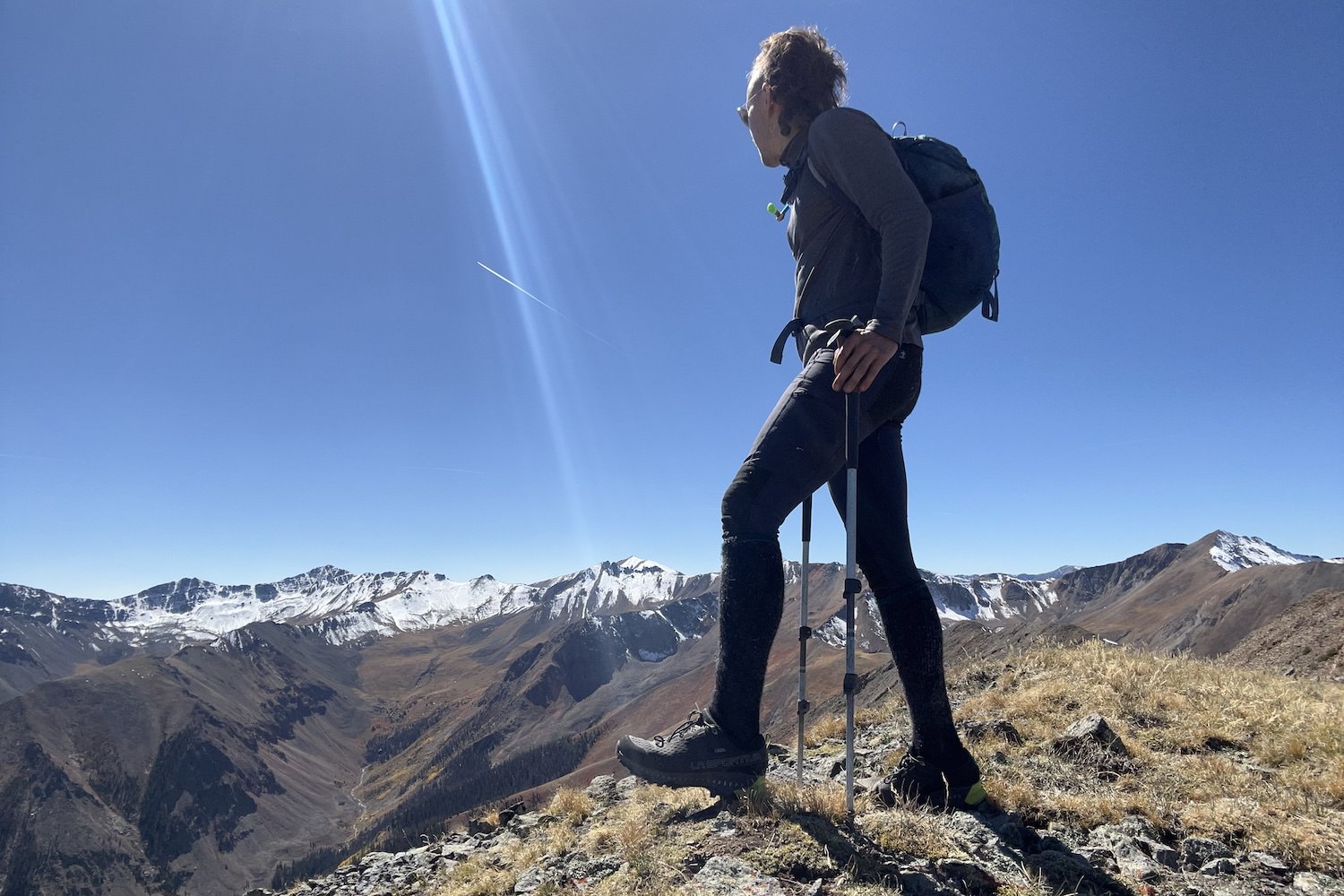
Why Trust CleverHiker
We’ve collectively run, hiked, and backpacked over 25,000 miles and 3,000 days in hiking shoes to identify the top-performing models. Gear Analyst and lead tester, Ian Krammer, has climbed all 58 of the Colorado 14ers (and many twice) in hiking shoes from this list. He’s also climbed more than 400 peaks over 13,000 feet over the last 8 years, which has given him a deep understanding of where these shoes truly excel, or fall short.
Gear Analyst Miles Knotek conducted additional reviews to cover new and updated shoes for 2025. A self proclaimed shoe geek, Miles has been experimenting with footwear ever since making his first pair of sandals out of paracord and a truck’s mud flap as a teenager. He loves exploring the ins and outs of his shoes and is meticulous in finding the right shoes for the right conditions. He firmly believes that the correct number of shoes to own is “N+1”. Based in Alaska, he regularly takes his shoes out in some of the harshest conditions. From rocky ridgelines to muddy trails, Miles can be found testing the limits of all his footwear on his many adventures.
Analysis & Results
We rate our hiking shoes on a variety of different dimensions – comfort, traction, weight, durability, and weather resistance. Check out how they performed in our real-world, hands-on testing.
VALUE
We understand one of the most critical factors is how much you spend on your shoes, and the value they bring you. We are always on the lookout for models that deliver excellent performance but are still fairly easy on your wallet. The Merrell Moab 3 stands out as our favorite budget option, offering exceptional durability, comfort, and traction at one of the lowest prices on this list. The Saucony Peregrine 15 is another great option for a high value shoe. Its impressive lightweight performance combined with its attainable price point make it perfect for a high performance shoe that punches far above its price point suggests.
COMFORT
When it comes to comfort, all of the shoes on our list are excellent options – although a few stand out as super cozy right out of the box. Our top choice for comfort is the Hoka Speedgoat 6, providing exceptional cushioning and a plush feel thanks to its thick midsole and responsive foam. This design reduces impact and offers a smooth ride, even on the roughest trails.
Also near the top are the TOPO Athletic Ultraventure 4 and the Merrell Moab 3. The Topo Athletic Ultra Venture 4 continues to be an extremely comfortable shoe for logging high mileage. Its plush midsole combined with a wide yet secure platform make it comfortable no matter your foot shape. The Merrell Moab 3 is one of our favorites for its fit and ample interior padding, which cradles the foot comfortably while offering excellent arch support. Both shoes will keep your feet happy on the trail and ensure you can hike for hours without discomfort.
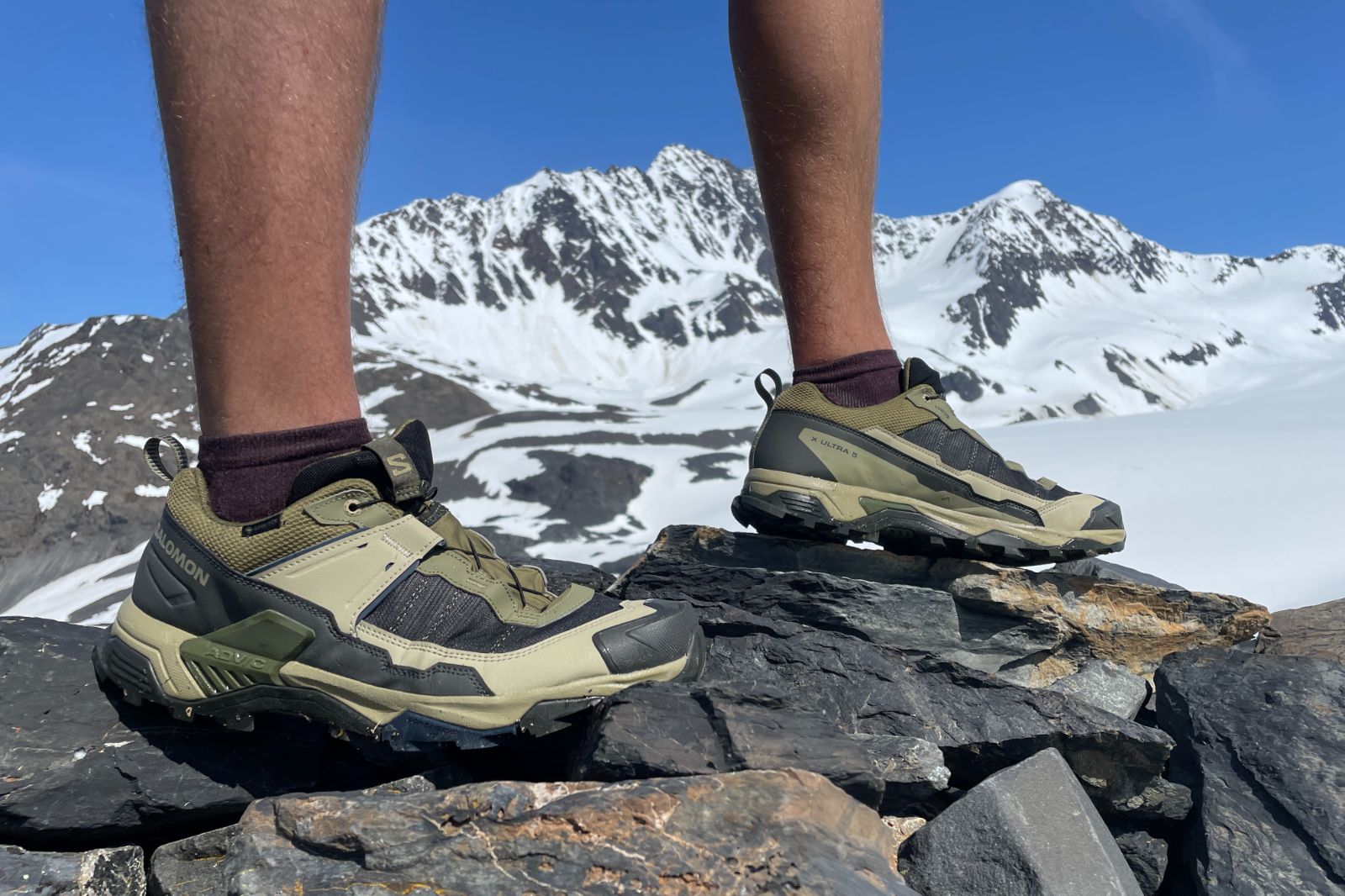
TRACTION
Getting a grip matters when you’re hiking. While all of the shoes on this list will keep you secure on most terrain, a few are truly the best in our experience. The Salomon X Ultra GTX 5 leads the pack with its Contagrip sole, which provides excellent bite on both wet and dry surfaces. Its multi-directional lugs enhance stability and control while moving, making it an ultra reliable choice for ascent and descents on all sorts of terrain. The La Sportiva Prodigio impresses with its sticky lugs and powerful grip. We love the dual density rubber for both traction and durability for mile after mile of wet and rocky trail.
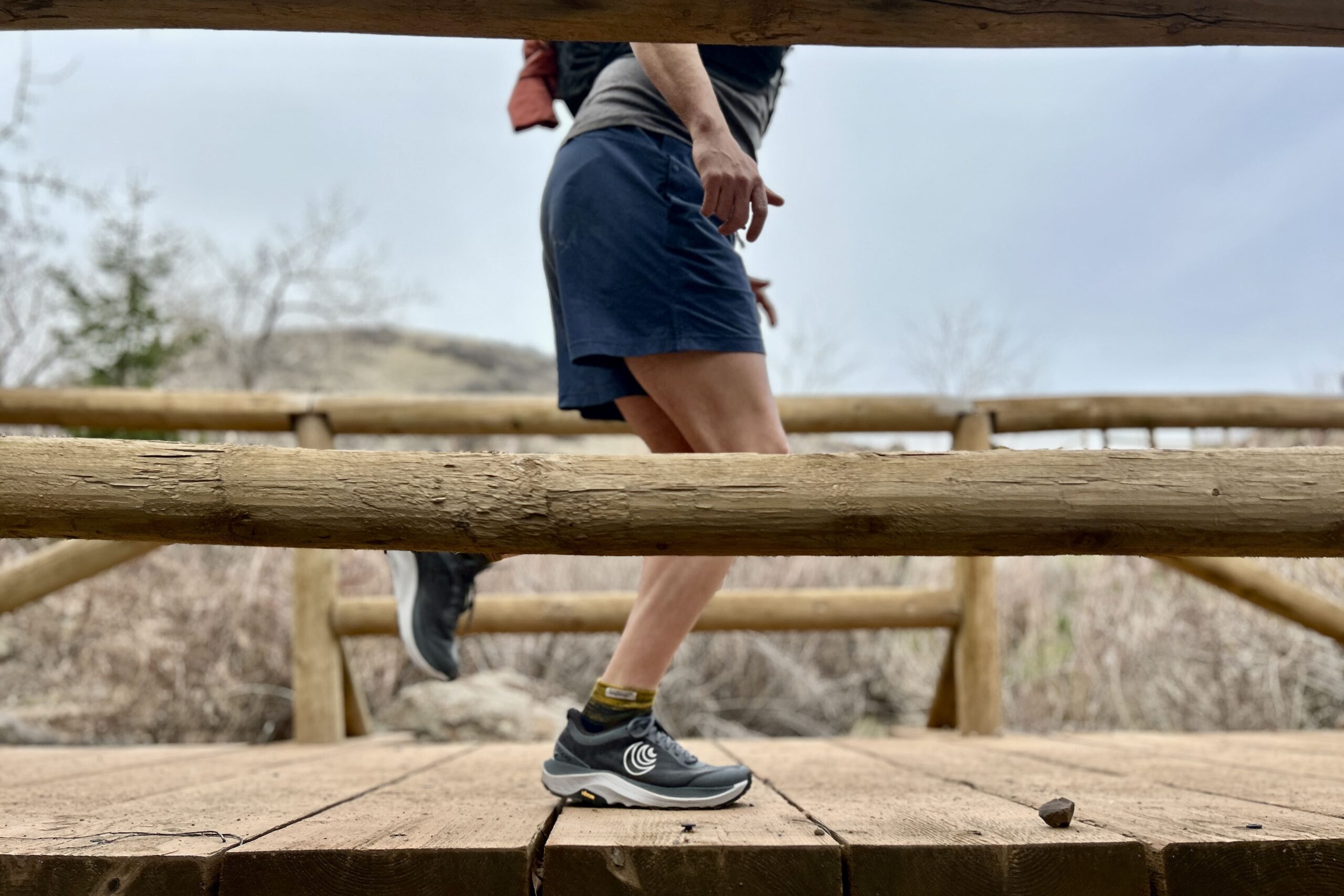
WEIGHT
The trail running shoes on our list offer more weight savings than shoes specifically made for hiking. It’s tough to beat our top contender, the Topo Athletic Ultraventure 4. This Topo model is a standout due to its lightweight materials, making each step feel airy and effortless. This lightness translates to less overall fatigue on long hikes, allowing you to cover more ground comfortably. The HOKA Speedgoat 6, La Sportiva Prodigio, and Saucony Peregrine 15 also offer lightweight performance since they were made for trail running, not hiking.
Among the hiking shoes we reviewed, the Danner Trail 2650 is the lightest option, making it a good trail to town shoe.
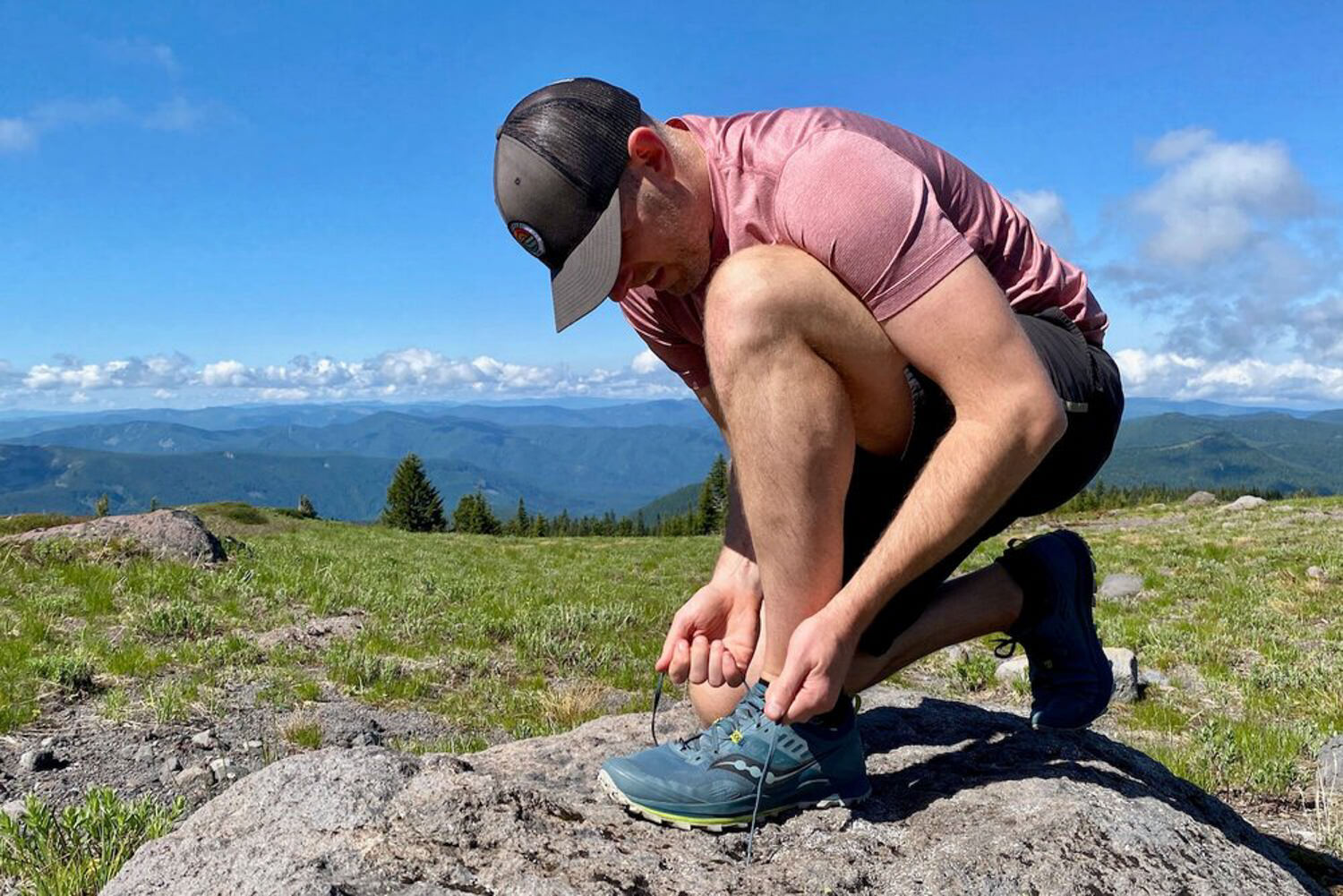
DURABILITY
At the top of our list for durability is a tie between the La Sportiva Spire GTX and the Salomon X Ultra 5 GTX. The La Sportiva Spires are built to last with a burly upper with abrasion-resistant materials that offer excellent protection against wear and tear. The robust construction and sturdy Vibram outsole make it ideal for hikes of any length while providing reliable traction and support on rugged terrain.
The X Ultra GTX boasts a similarly tough synthetic upper offering exceptional durability on sharp rocks and root-filled trails. Built with Kevlar like material, we found it held up extremely well no matter what we threw at it. Its updated chassis and excellent outsole lend serious longevity even during the longest hikes over the most challenging terrain – and they’ll last several seasons.
WEATHER RESISTANCE
Several hiking shoes on our list are waterproof and do a solid job of it. However, we generally find that GORE-TEX waterproofing outperforms most brands’ proprietary waterproof membranes. The Salomon X Ultra 5 GTX, La Sportiva Spire GTX, and HOKA Anacapa 2 GTX each boast a GORE-TEX Membrane that delivers exceptional waterproofing and breathability.
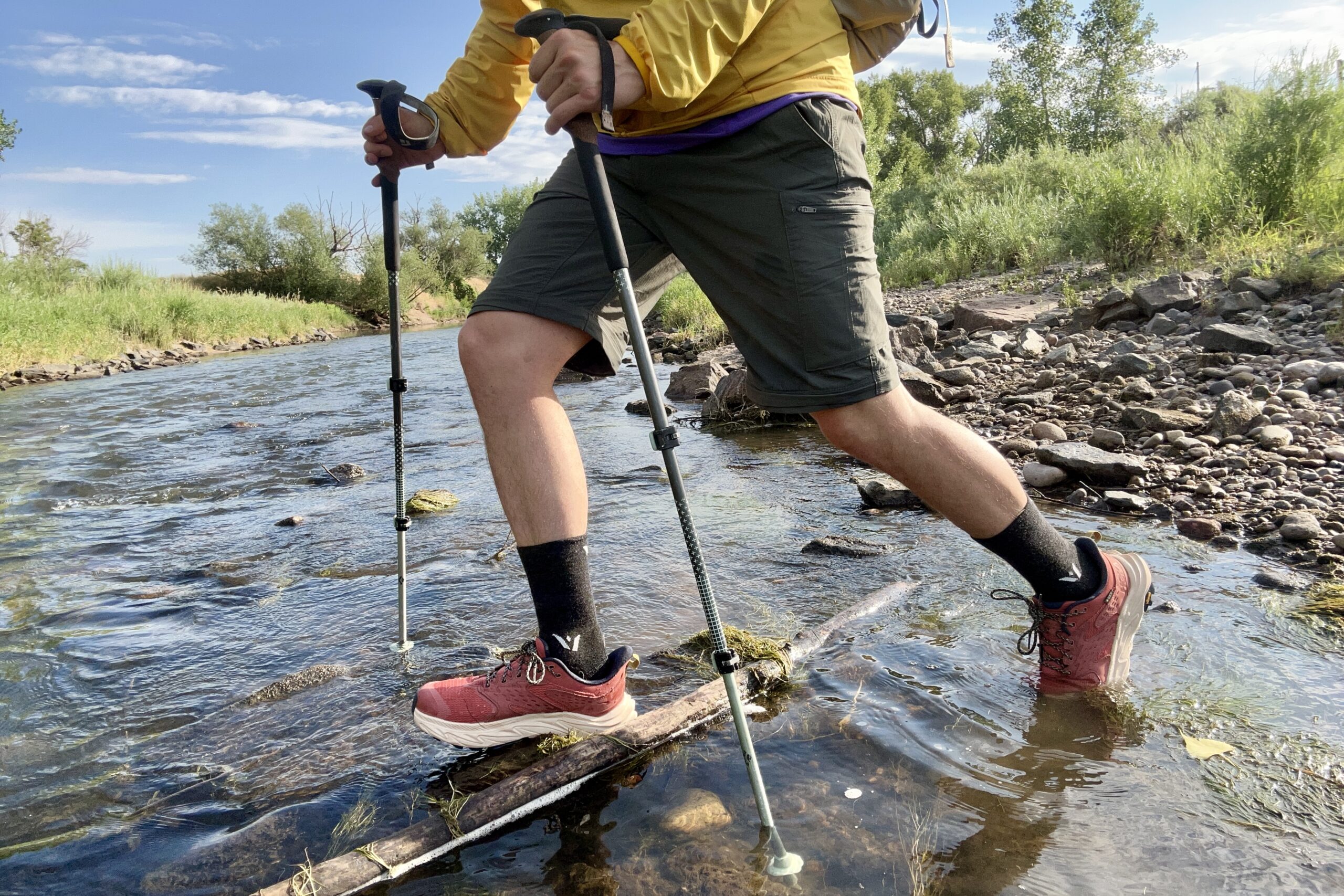
How to Choose Hiking Shoes
BOOTS VS. SHOES VS. TRAIL RUNNERS
Which one to choose? The real answer is it depends, but we most often recommend lightweight synthetic trail runners, and our team has hiked tens of thousands of miles in them. Trail runners are more breathable than heavier traditional leather shoes, and feel much more comfortable over long distances. Having said that, classic hiking shoes are usually made with leather or a synthetic / leather hybrid, are often waterproof, more durable, and last longer. They’re ideally suited for off-trail exploration and sloppy trail conditions like rain or snow. However, they’ll be heavier and bulkier, so we recommend classic hiking shoes or high-top boots for shorter distances or hiking in spring and fall conditions. Check out this article to find the right fit for you.
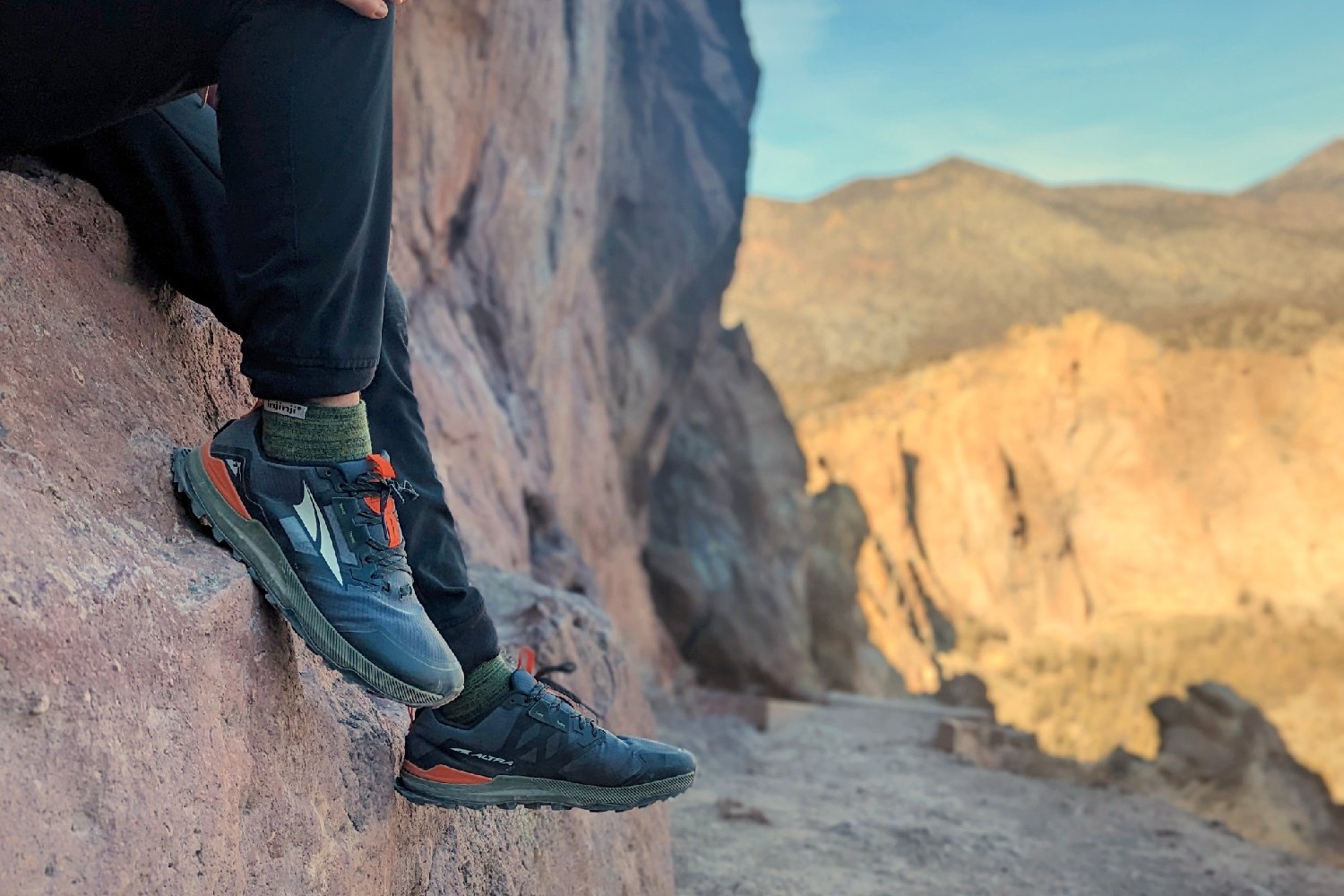
SIZING
In general, we recommend purchasing hiking footwear at least half a size bigger than your normal shoes, especially if you’re between sizes or at the edge of one size. During long hikes, feet tend to swell. The bit of extra wiggle room for your toes and forefoot can make all the difference for comfort and peace of mind when there are still miles to cover.
An easy way to measure if your footwear has enough room? The finger test. Simply loosen the laces of your boot, shoe, or trail runner, place your foot in the shoe so your toes are against the tip of the toe box, and stick your index finger between your heel and back of the shoe. Your finger should slide in easily. If there’s enough room, you’ll know your toes won’t jam against the front of the shoe during steep descents and long downhills, so you’ll avoid hot spots, pain, and nail damage.
Other elements can affect the way your shoes fit. Keep in mind what socks you’ll be wearing on trail and if they’ll take up additional space – we advise wearing the socks you plan to hike in when trying on shoes to ensure you get the right size. And, if you’ll be adding aftermarket insoles, accounting for a bit of extra room in the shoe will be helpful.
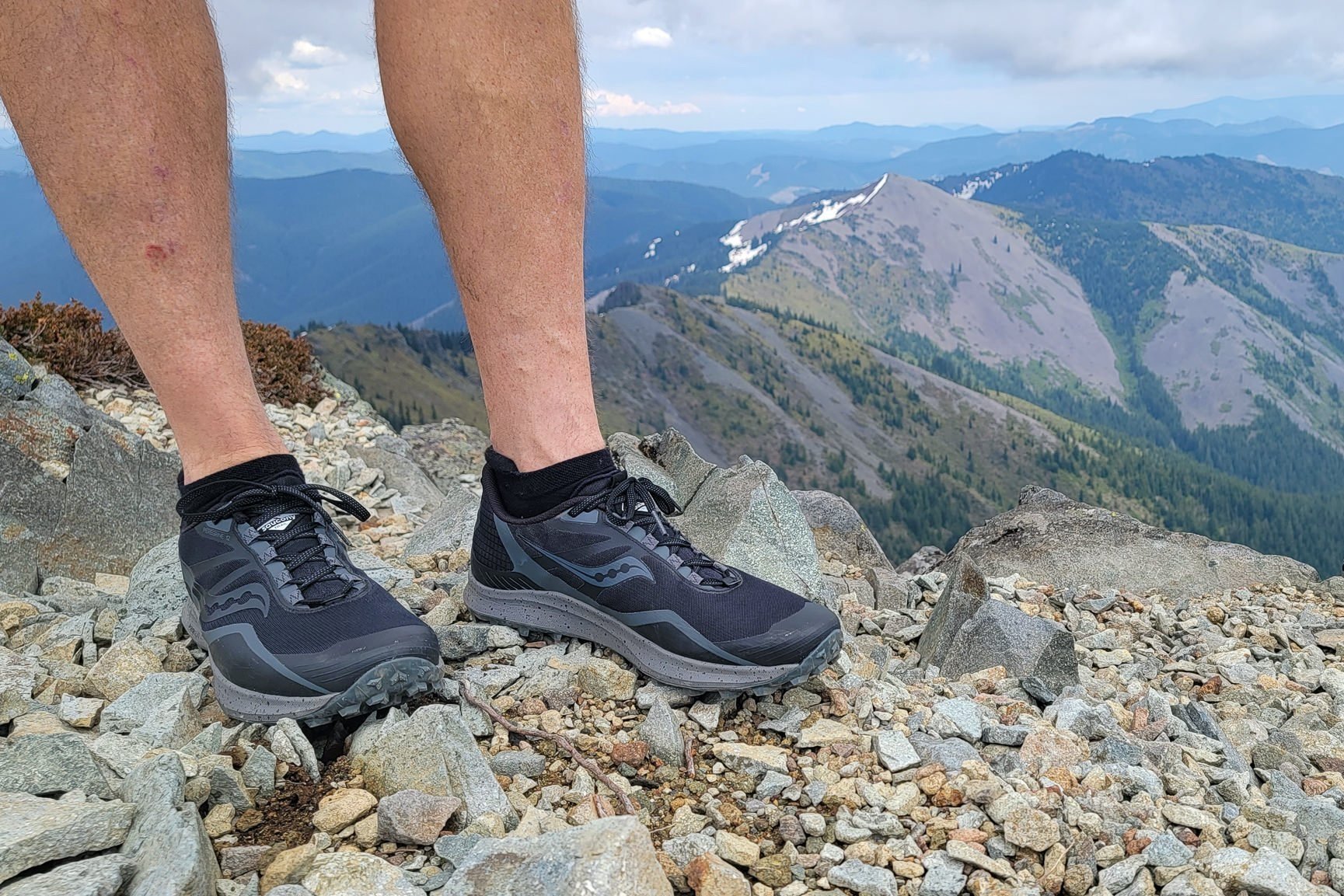
BREAK-IN PERIOD
While some of the shoes on this list are instantly comfortable out of the box, most footwear will require a break-in period. We recommend purchasing the boots, shoes, or trail runners you plan to take backpacking or hiking and wearing them every chance you get. By making them your go-to footwear for every grocery store run, dog walk, or local hike, your shoes will have time to soften and adapt to your foot, and you’ll avoid blisters or hot spots on your long hike. You’ll have plenty of time to get acquainted with your new kicks and address any issues before you’re miles deep in the backcountry.
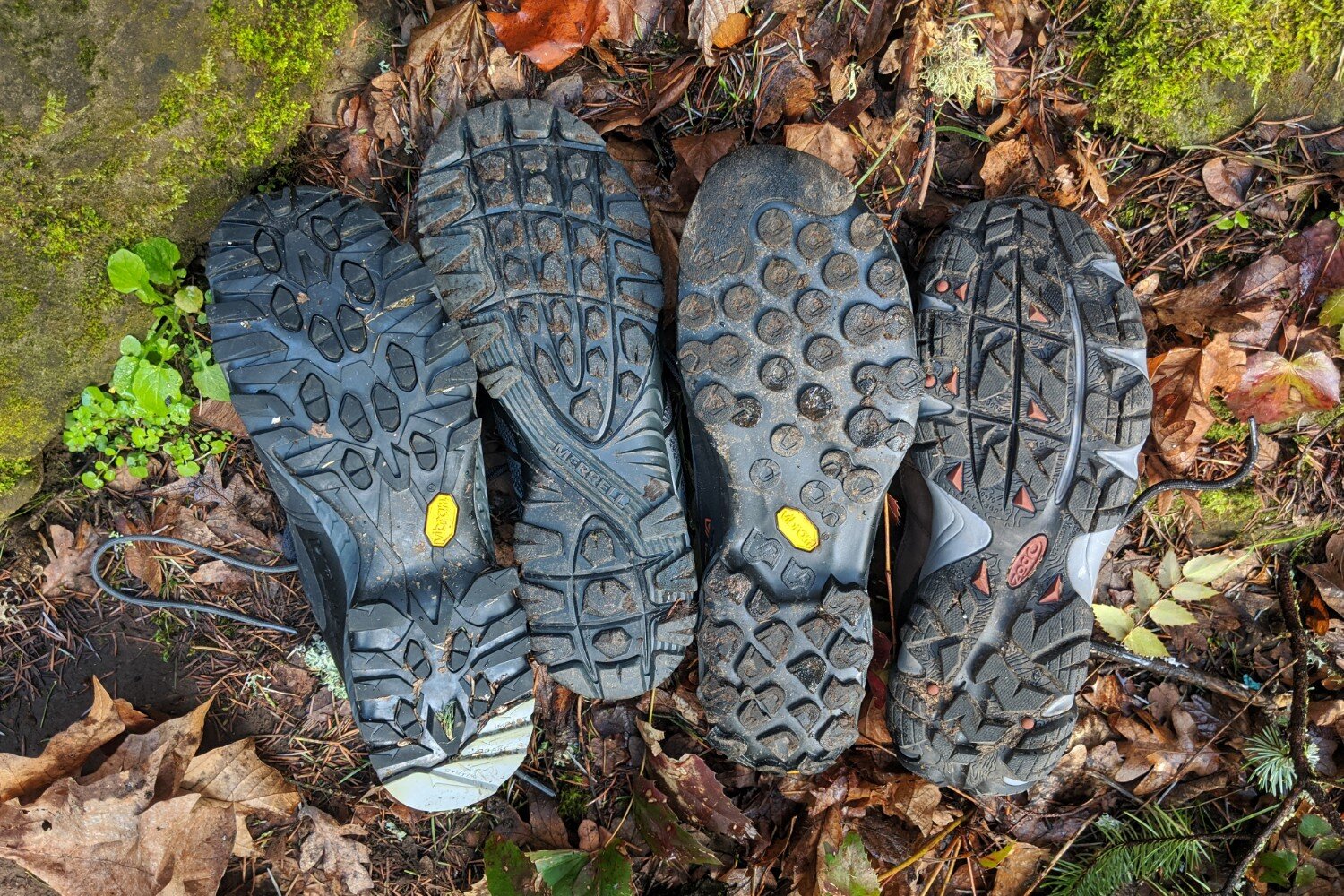
TRACTION
From steep, sandy ascents and slick creek crossings to hard-packed trails and jagged, rocky alpine routes, the grip pattern on your shoes matters a lot when hiking and backpacking. Your footwear should offer a reliable grip on the majority of surfaces, and bite the ground when you need it most – no matter what conditions you’re in. Traction, lug pattern, and grip were heavily factored into all of the footwear recommendations on this list.
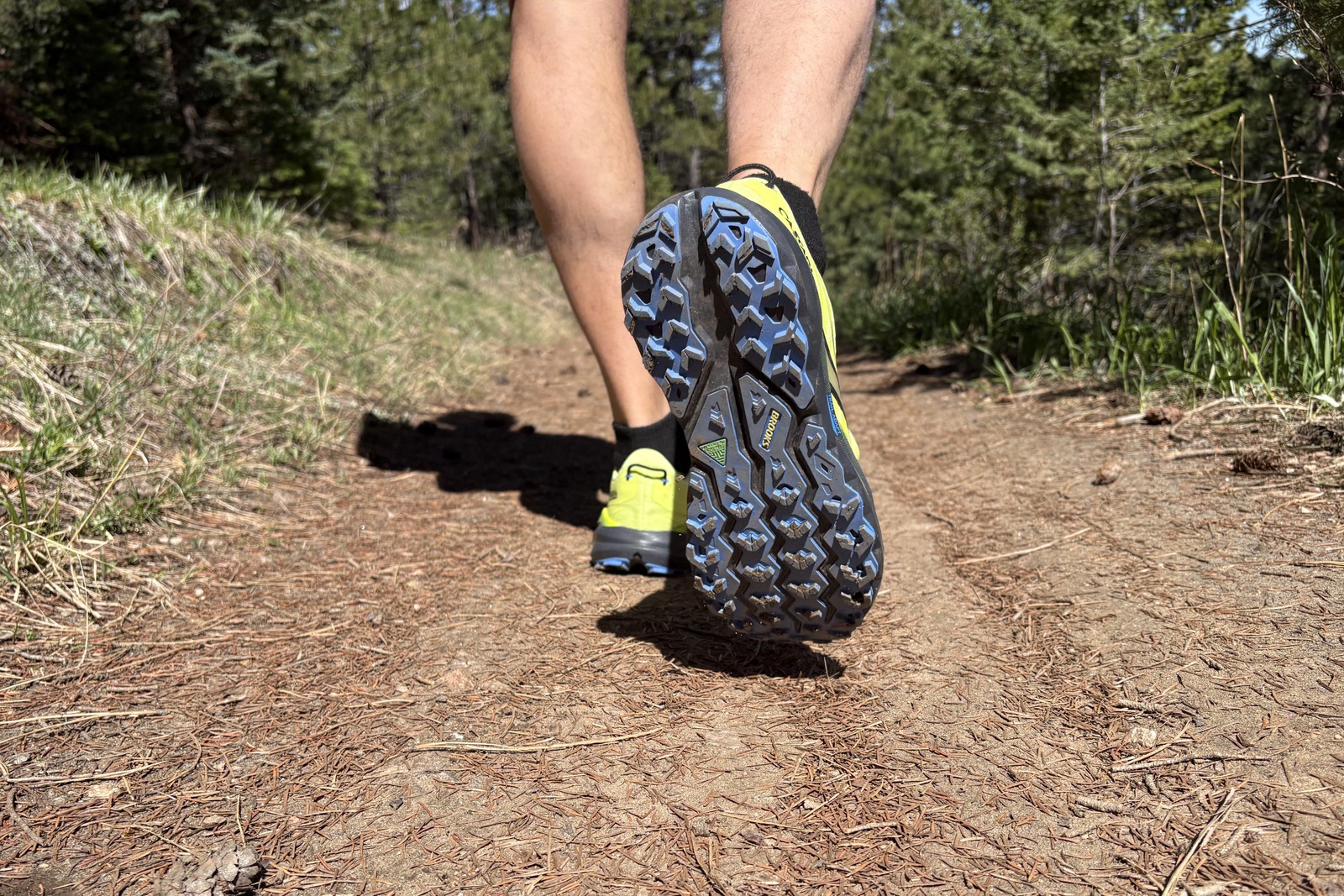
MANAGING MOISTURE & BLISTERS
At some point when hiking, your feet are going to get wet regardless of what shoes or boots you’re wearing – waterproof or not. Whether you trudge through a rainstorm, slip while fording a stream, or step in a puddle deeper than expected, wet feet are a real problem while hiking. Wet conditions can quickly lead to hot spots and blisters, but a healthy foot care routine can prevent most of the damage. Check out our guide to How to Prevent and Treat Blisters for our top tips on how to manage moisture and blisters.
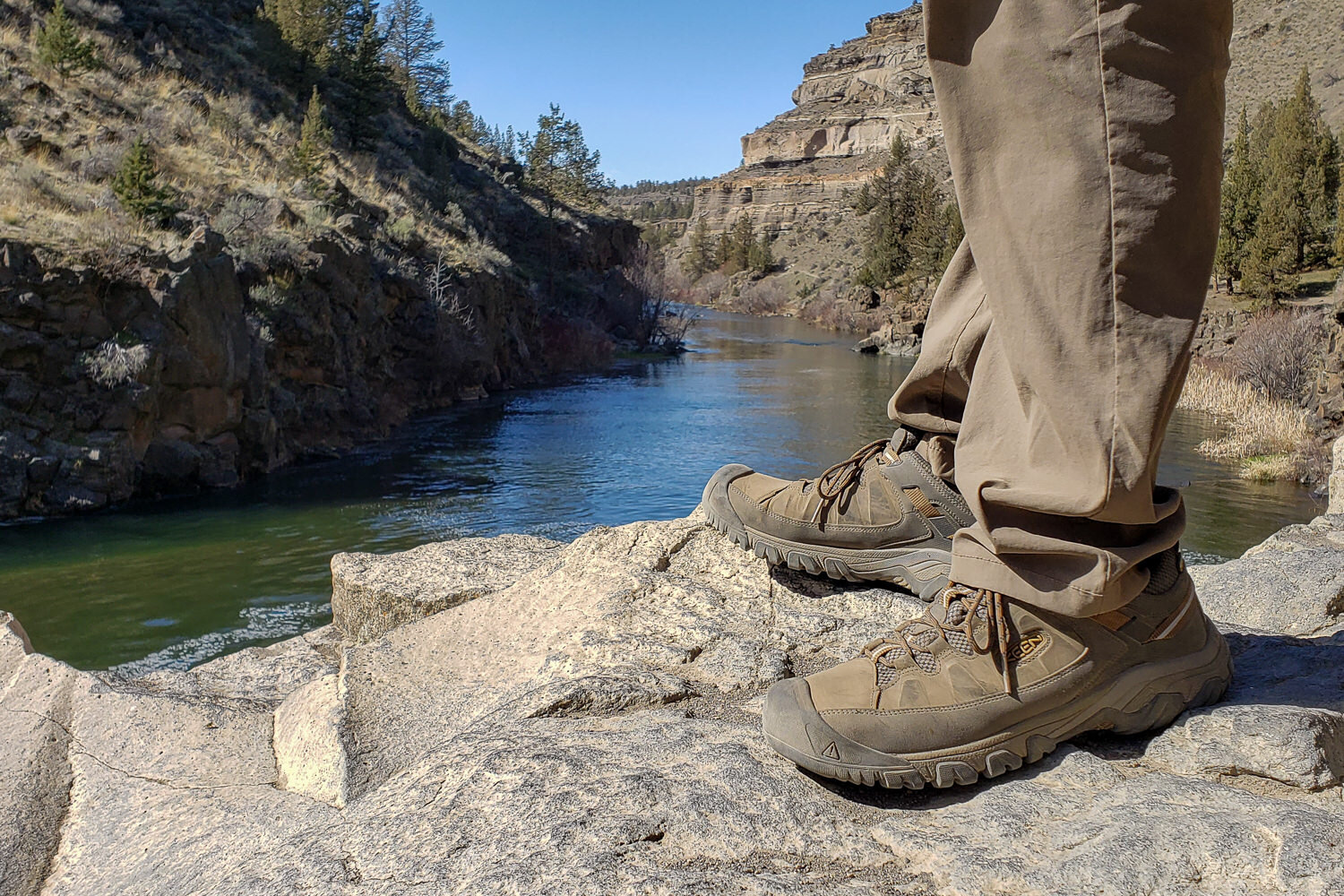
WATERPROOFING TREATMENTS
We’re big fans of waterproof hiking shoes for soggy days when we know we’ll encounter mud, snow, and rain. Unfortunately, “waterproof” doesn’t mean water will never find its way into your shoes – because it probably still will. Whether you’re hiking in a torrential downpour or dealing with light rain, water can drip down your legs and into your shoes. Even a misstep could easily soak your ankles. Remember that waterproof treatments wear off over time, so you’ll need to reapply a treatment to keep your shoes in tip-top shape. Luckily, this process is fast, easy, and (mostly) painless.
There are waterproof and non-waterproof versions of most shoes on this list. We recommend first finding the hiking shoe that fits your needs, then determining if you’ll need a waterproof or non-waterproof option.
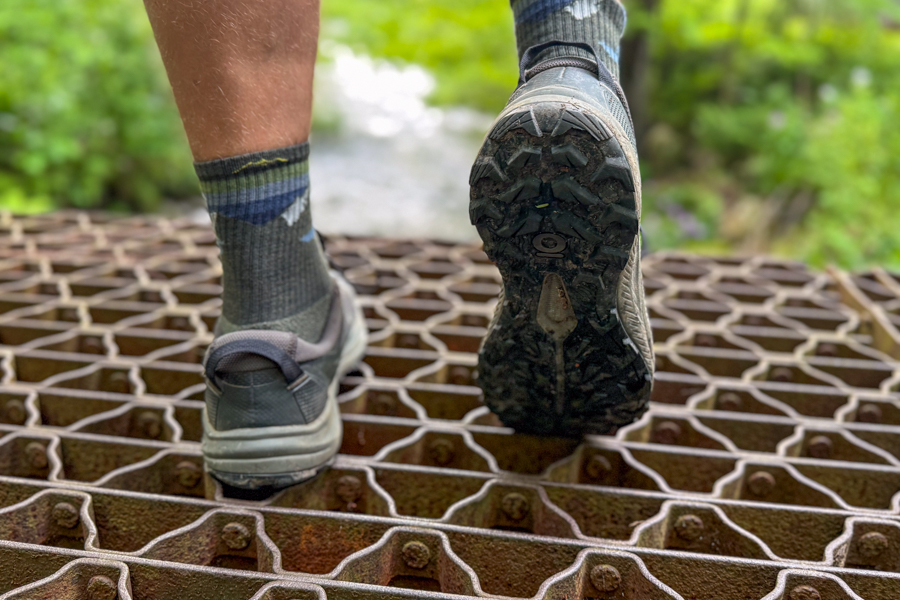
Waterproof hiking shoes are best for mucky and wet trail conditions. We recommend Gore-Tex or other waterproof options during the shoulder seasons, where spring rain and early fall snow and melt can turn packed trails into slippery, muddy adventures. However, waterproof shoes fall short on warm days, when they’ll feel hot and sweaty due to a lack of breathability. Also, they can be very slow to dry if they get wet.
Non-waterproof hiking shoes are best for drier conditions, multi-day trips, and thru-hikes. Thanks to mesh uppers, they are breathable and lighter, so they dry faster and keep your feet cool – perfect for sunny summer days. Even though non-waterproof shoes tend to soak through if they get wet, they dry much faster. That’s why many backpackers – and our team at CleverHiker – are big fans of non-waterproof shoes for hiking from June to September.
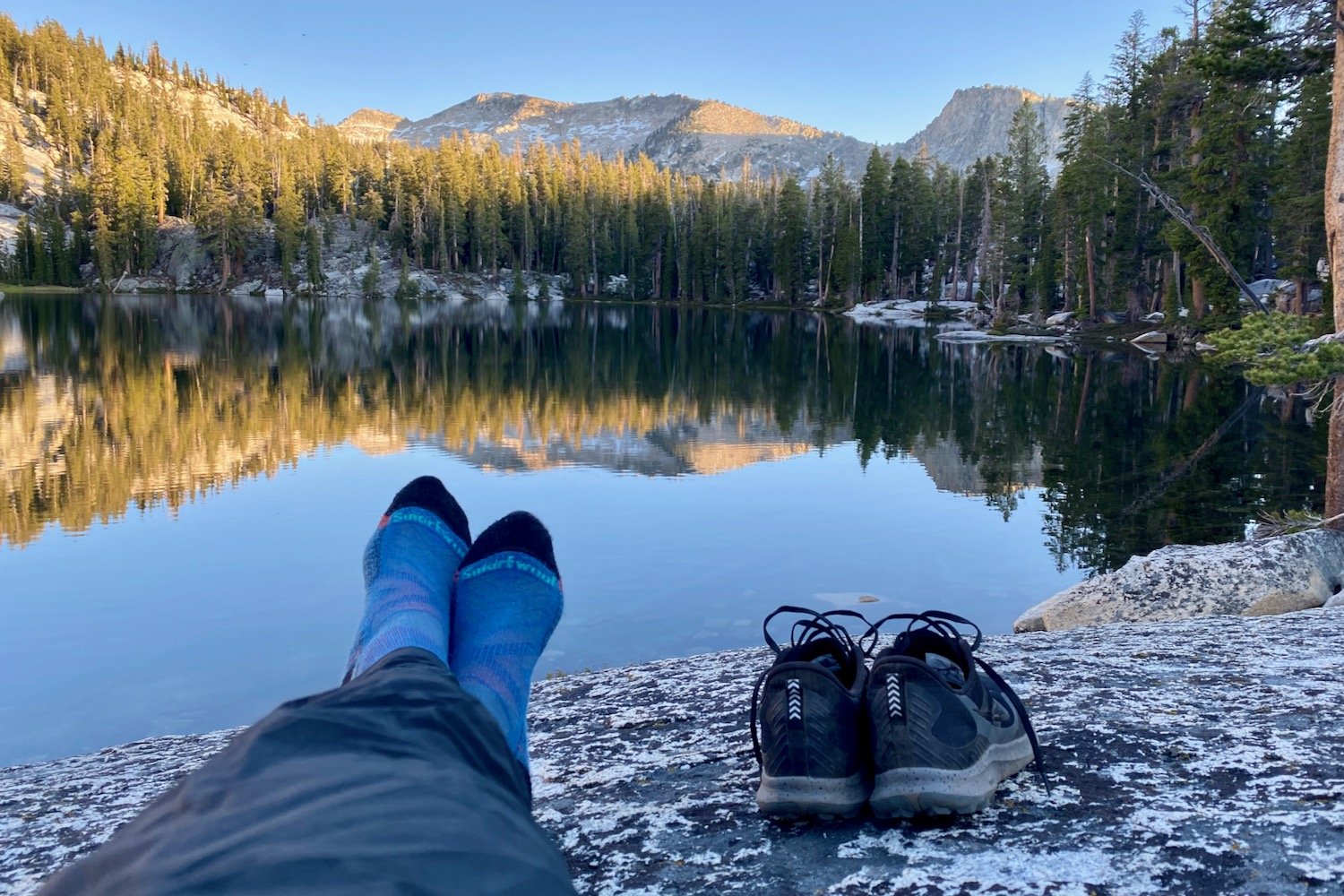
SOCKS
Our team has collectively hiked tens of thousands of miles and learned the hard way that quality socks are as essential as top-quality shoes. In fact, they are vital for the health of your feet and your overall well-being on trail. The ideal hiking socks are comfy, durable, fit well, wick moisture away from your skin, and dry quickly. Take a look at our guide to the Best Hiking Socks.
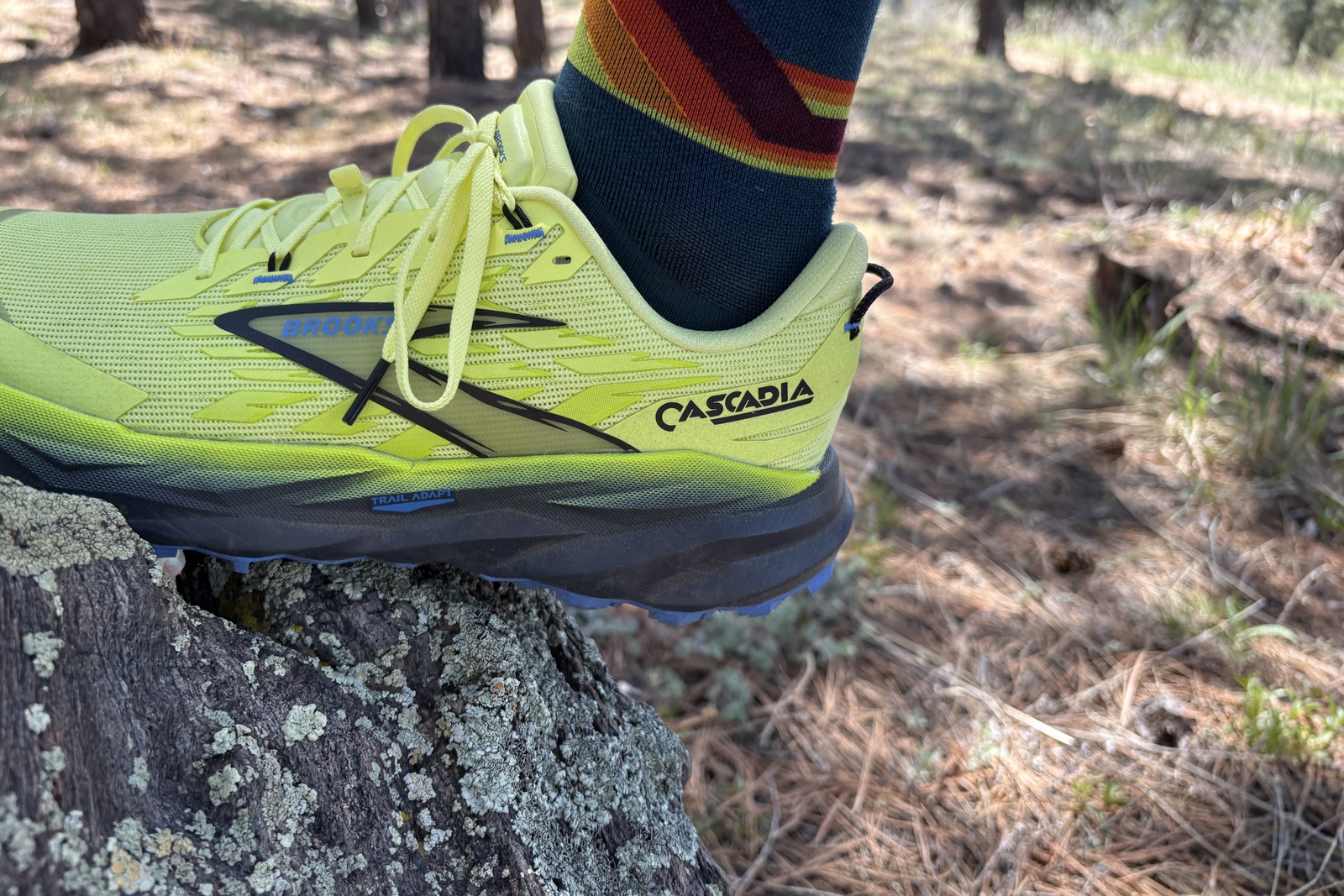
INSOLES
Aftermarket insoles can help prevent foot fatigue. Those who suffer from plantar fasciitis, flat feet, and shin splints can benefit from the extra stability, but we also recommend them for anyone who needs additional cushioning and arch support. Insoles can be a cure-all solution for rigid shoes or pairs that have little support. They can also help take up a bit more space to achieve that customized fit for folks who are between sizes or want a tighter fit.
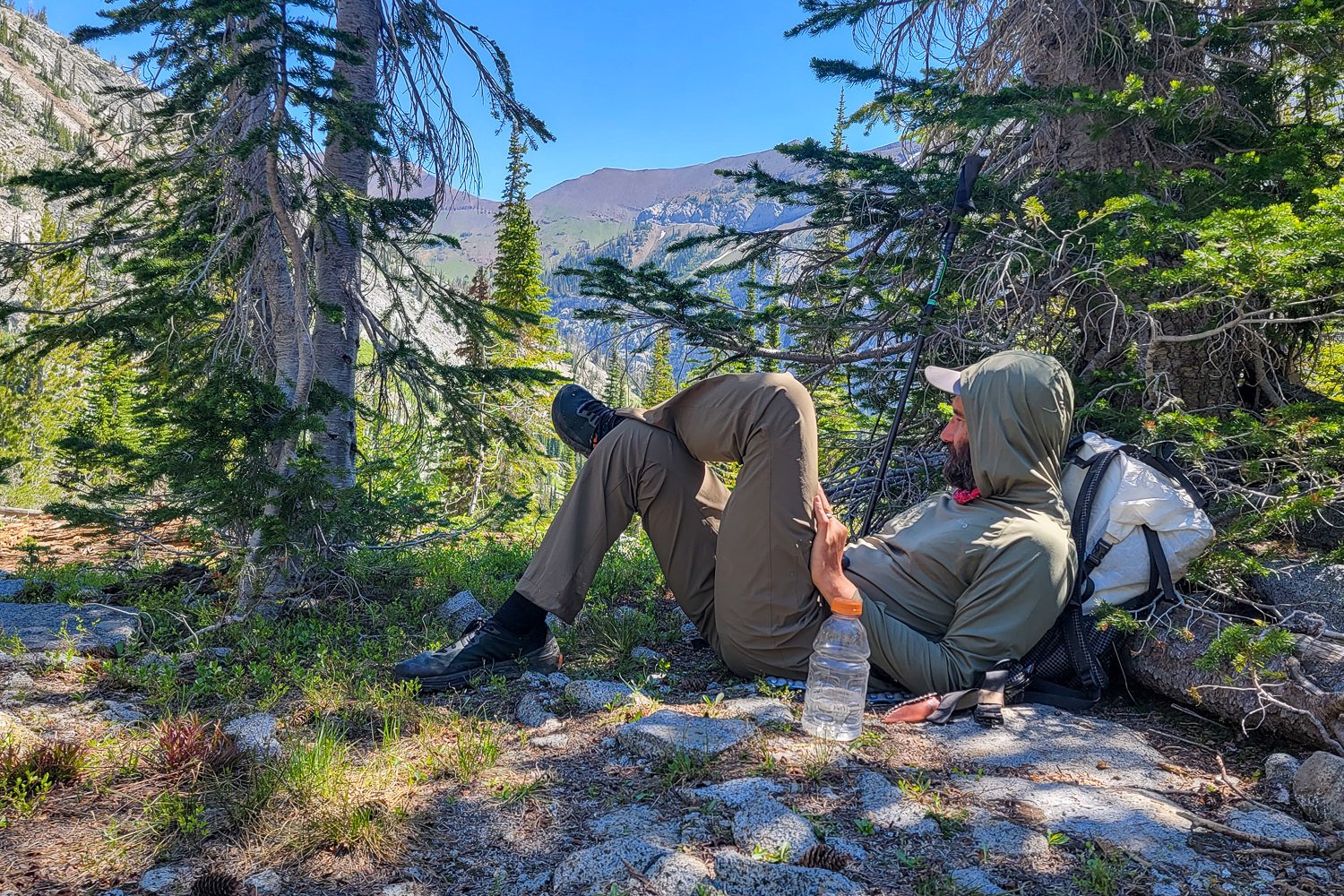
Conclusion
Selecting the right pair of hiking shoes is essential for a comfy and fun outdoor experience. From rugged trails to unpredictable weather, the durability, comfort, and weather resistance of men’s hiking shoes play a crucial role in your safety and happiness on the trail. With so many options out there, finding the perfect pair for your feet will get you into the great outdoors and we hope this guide is a step in the right direction.



